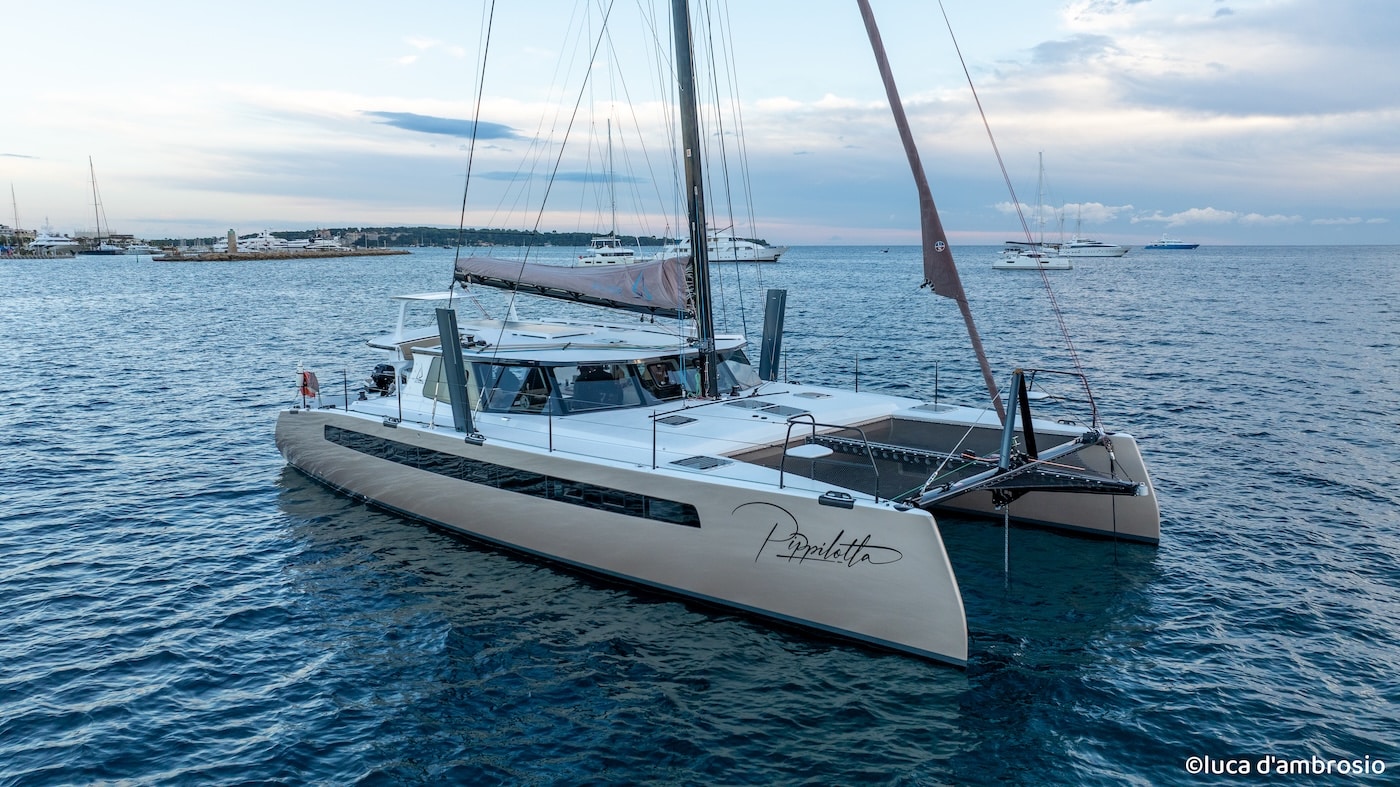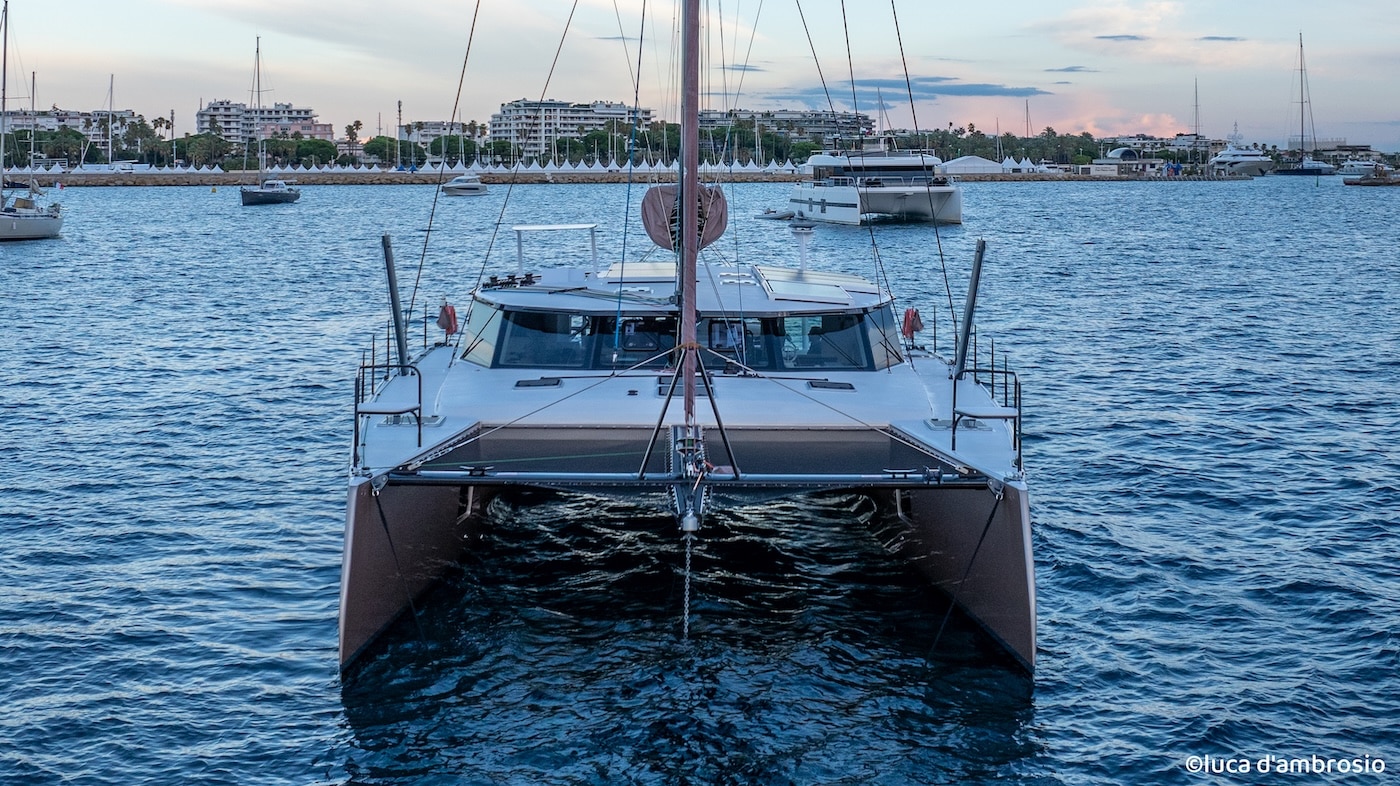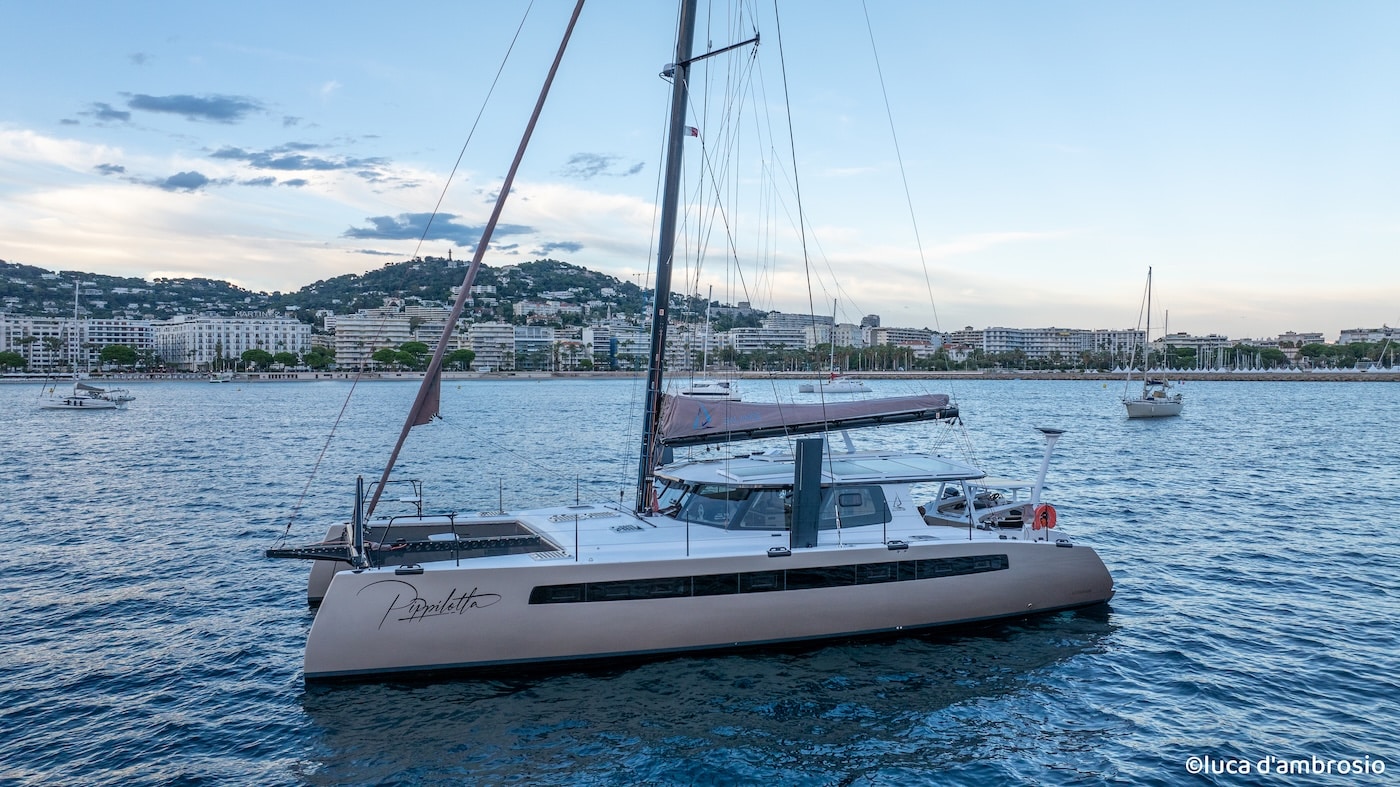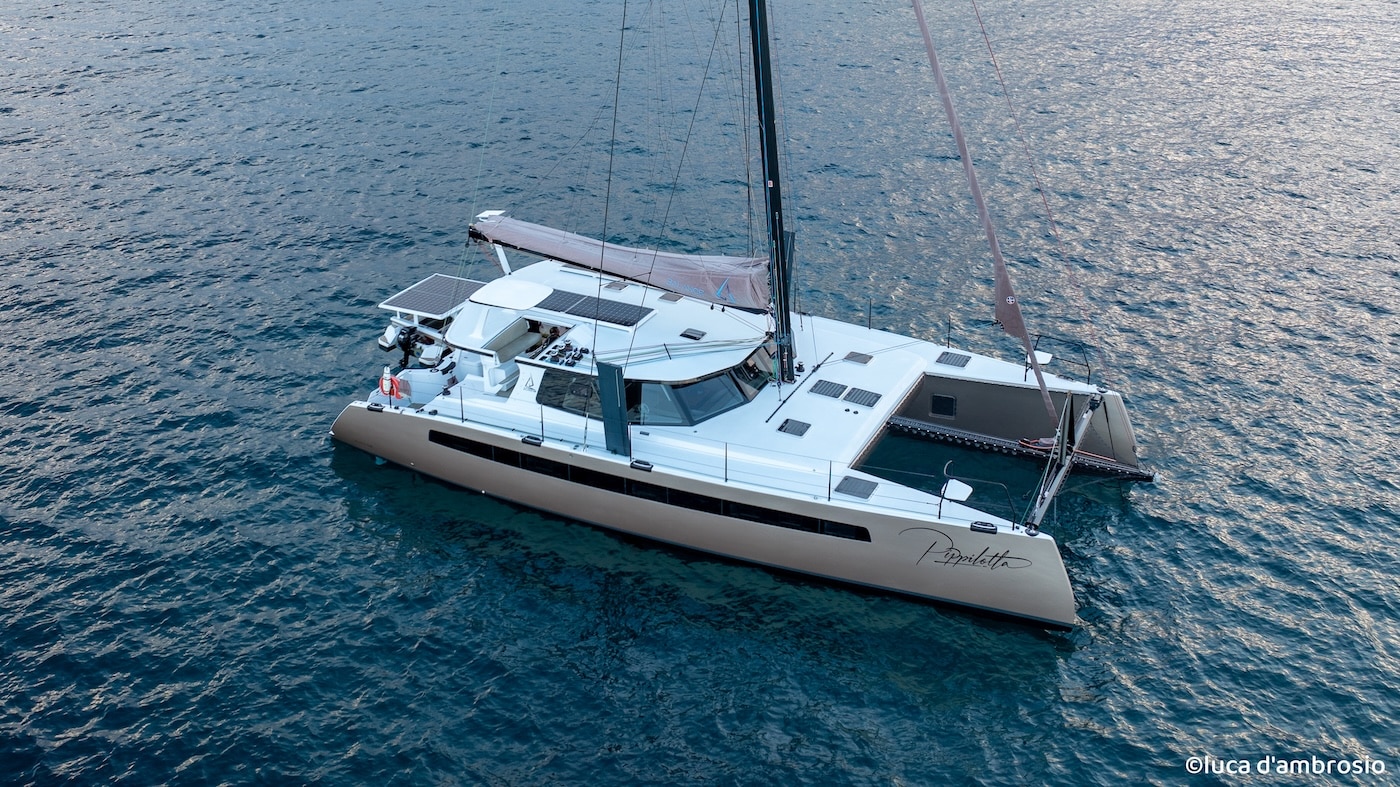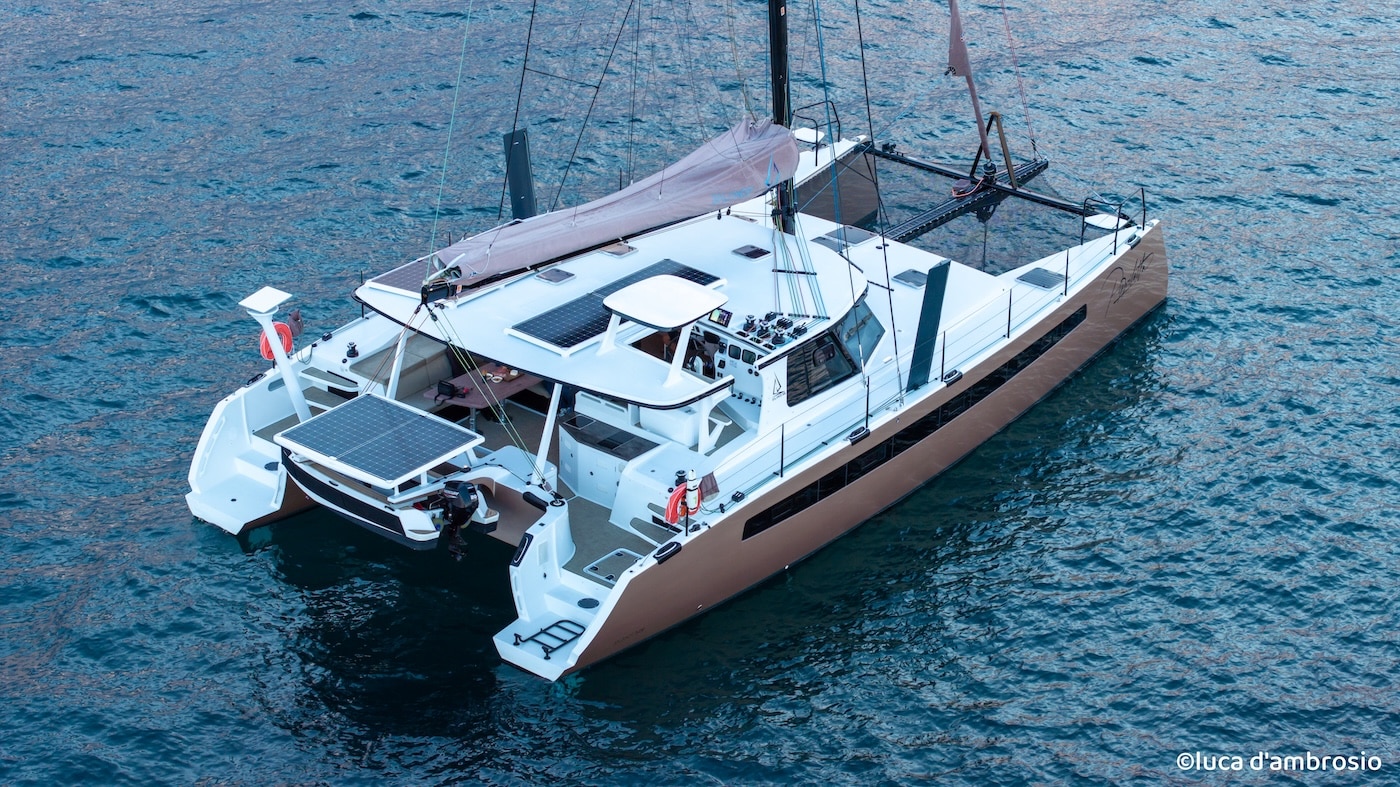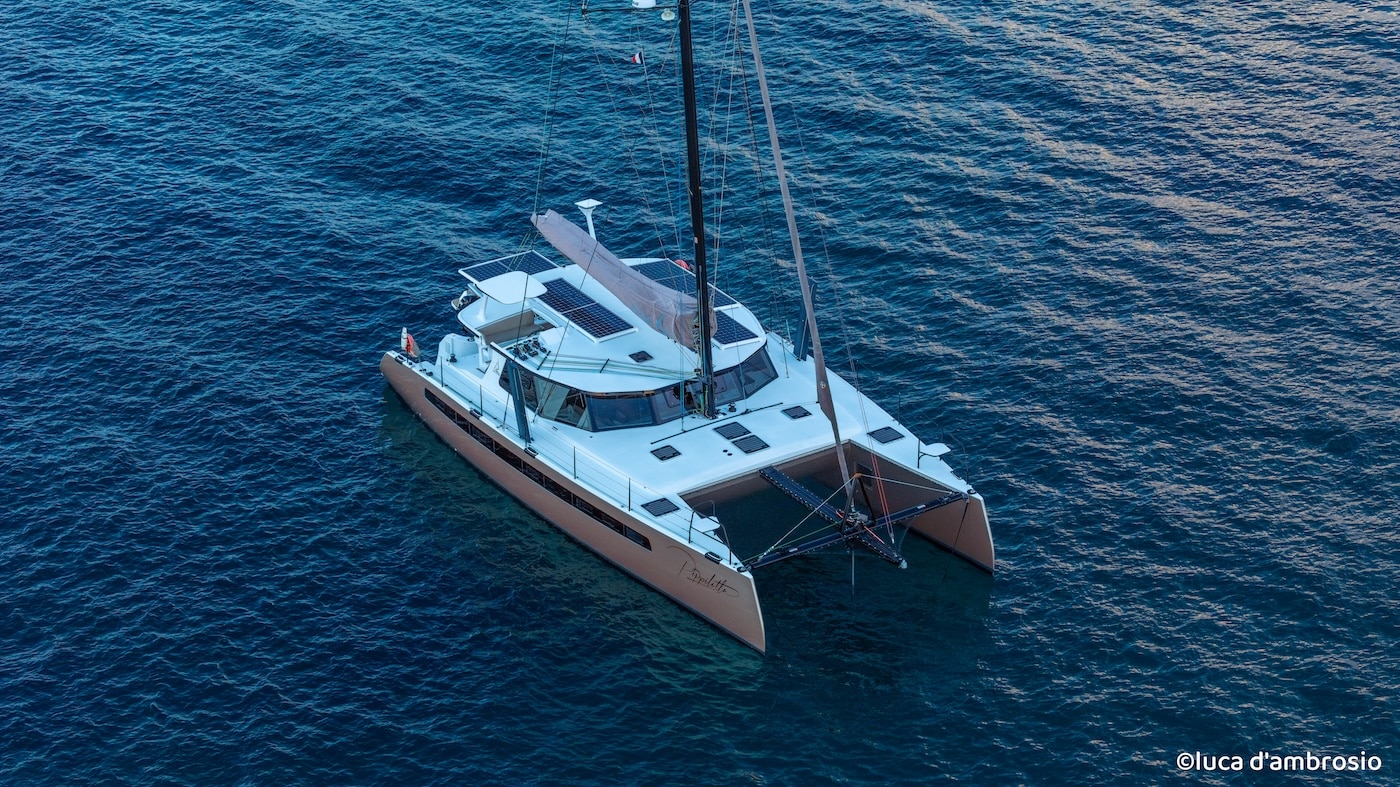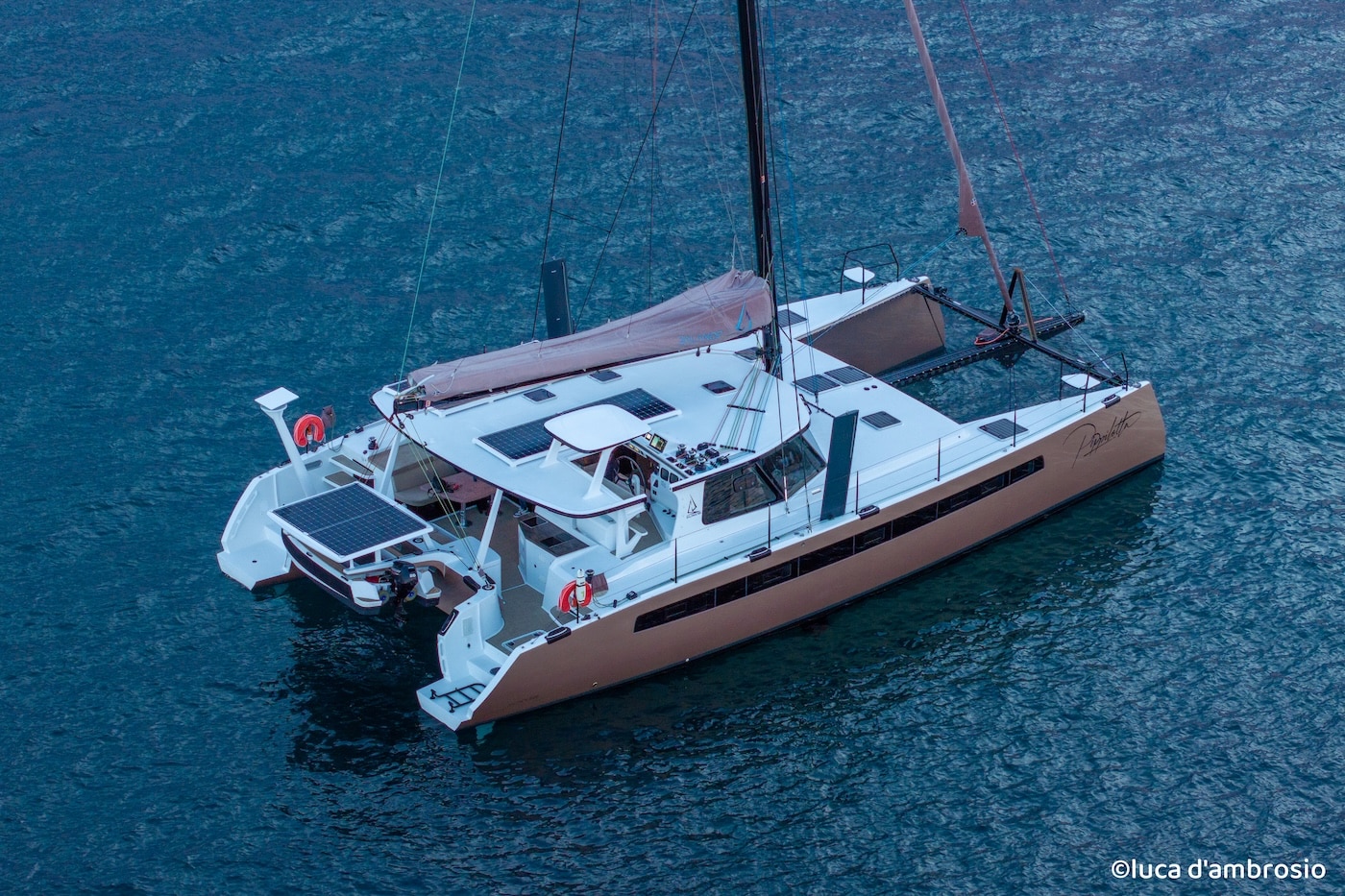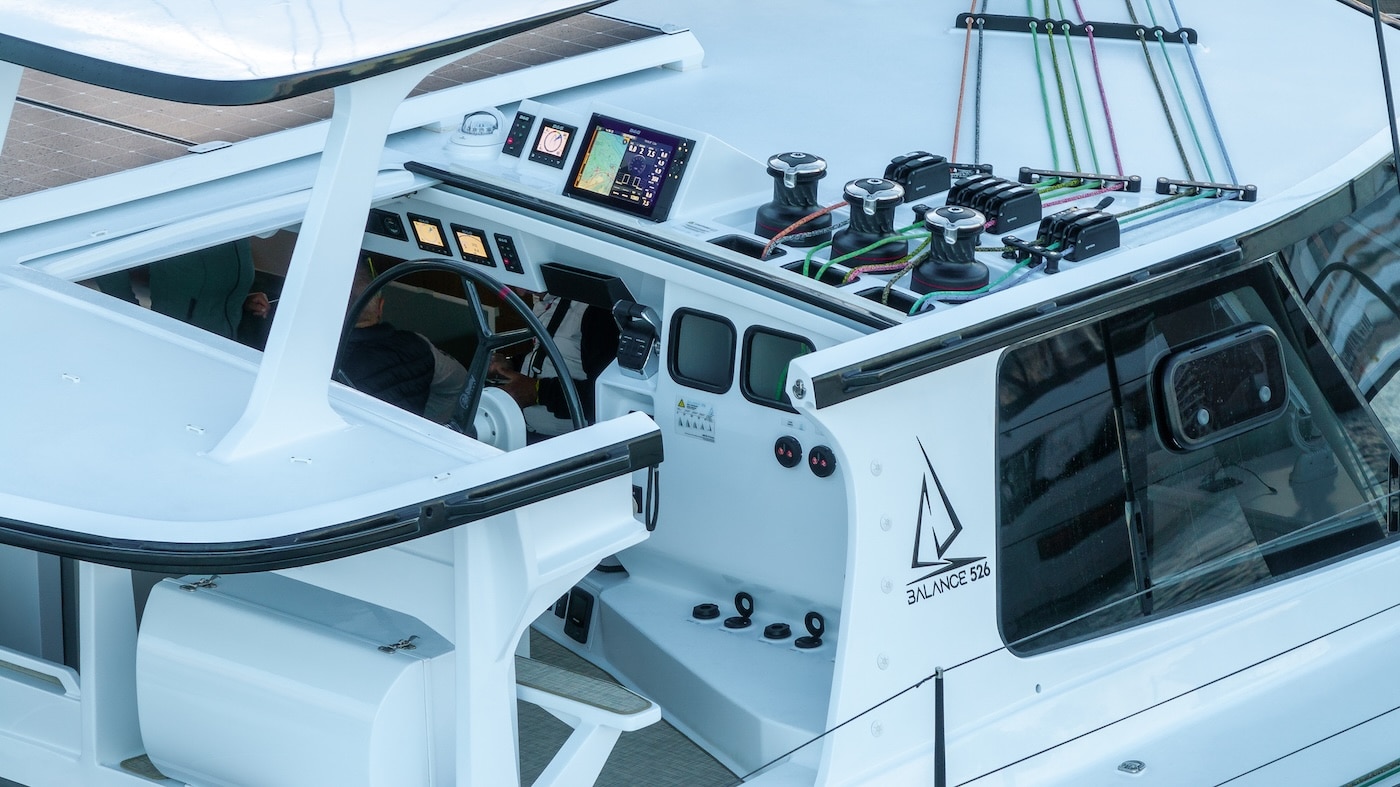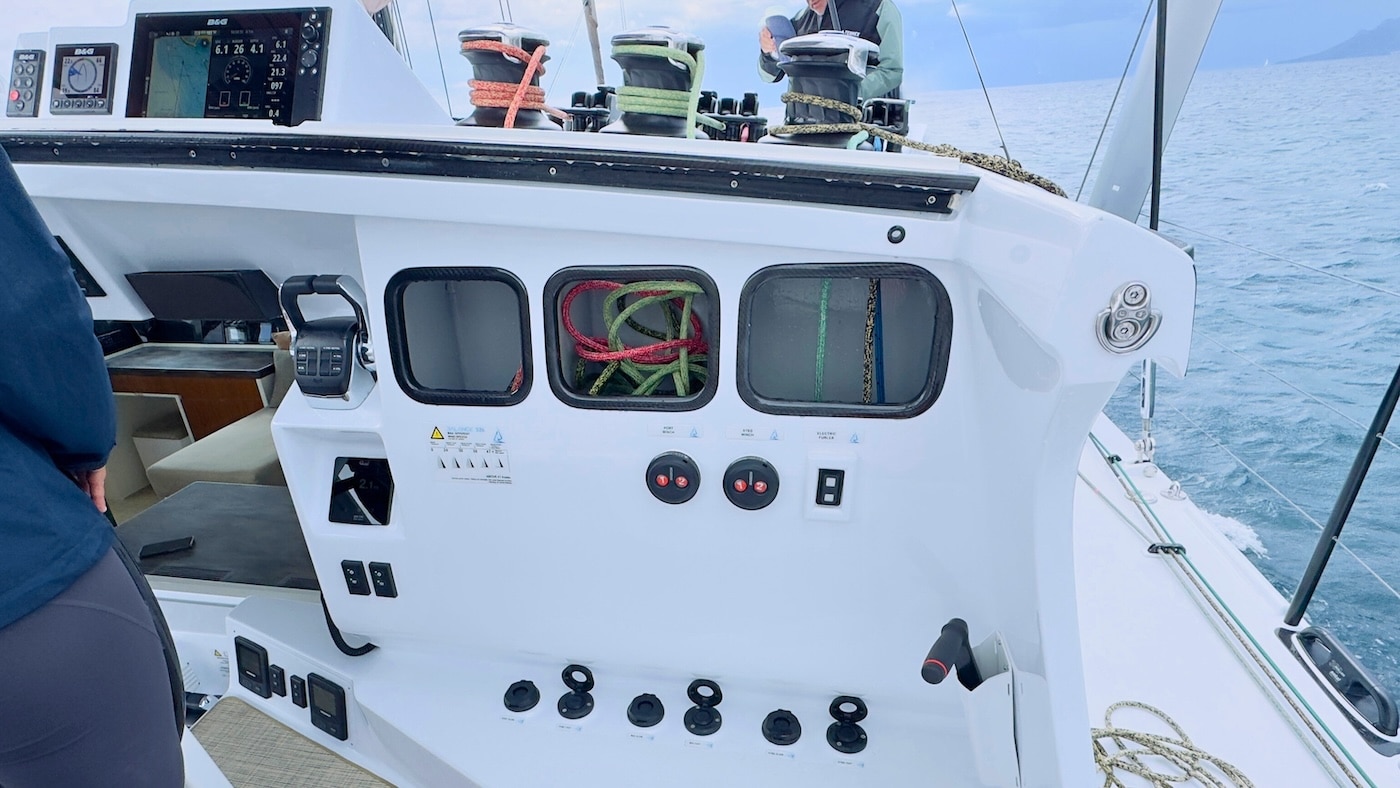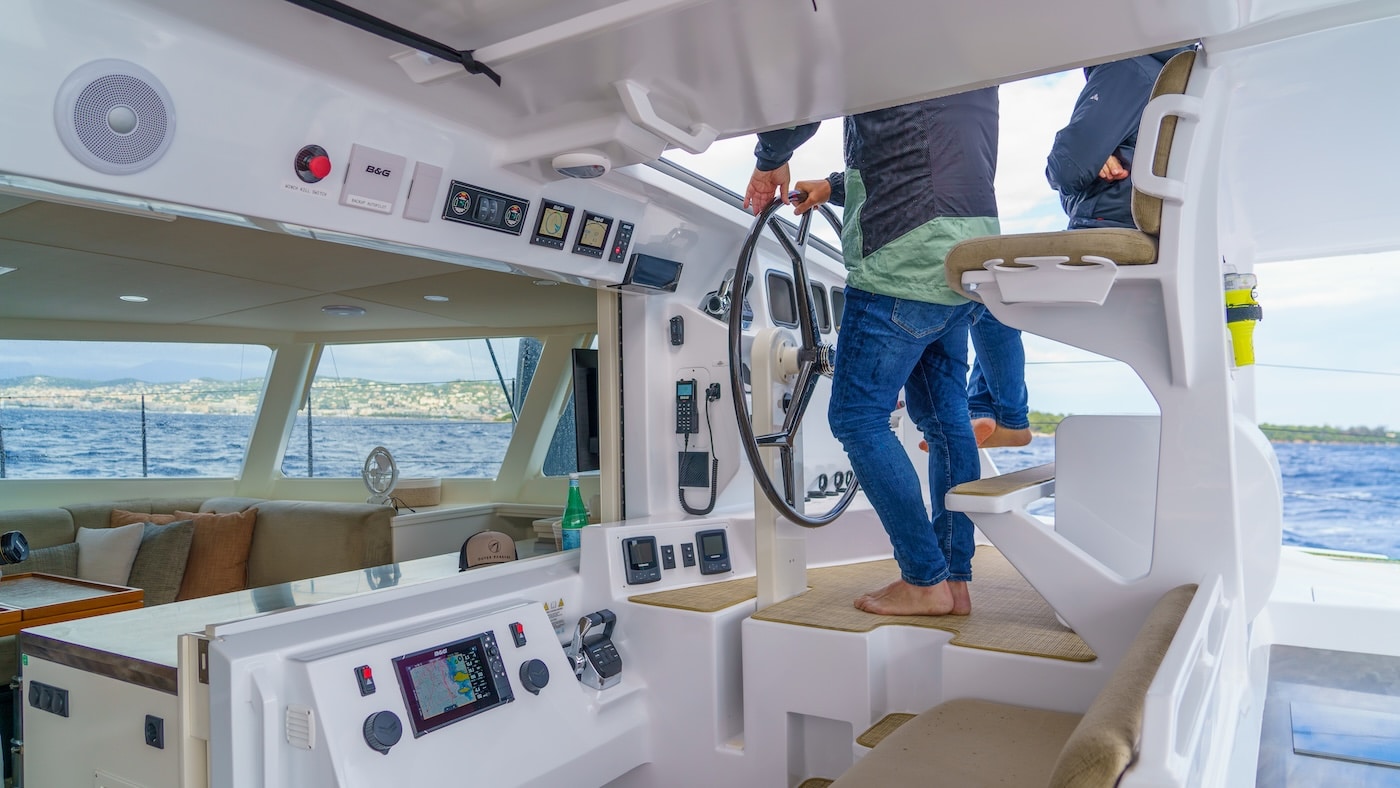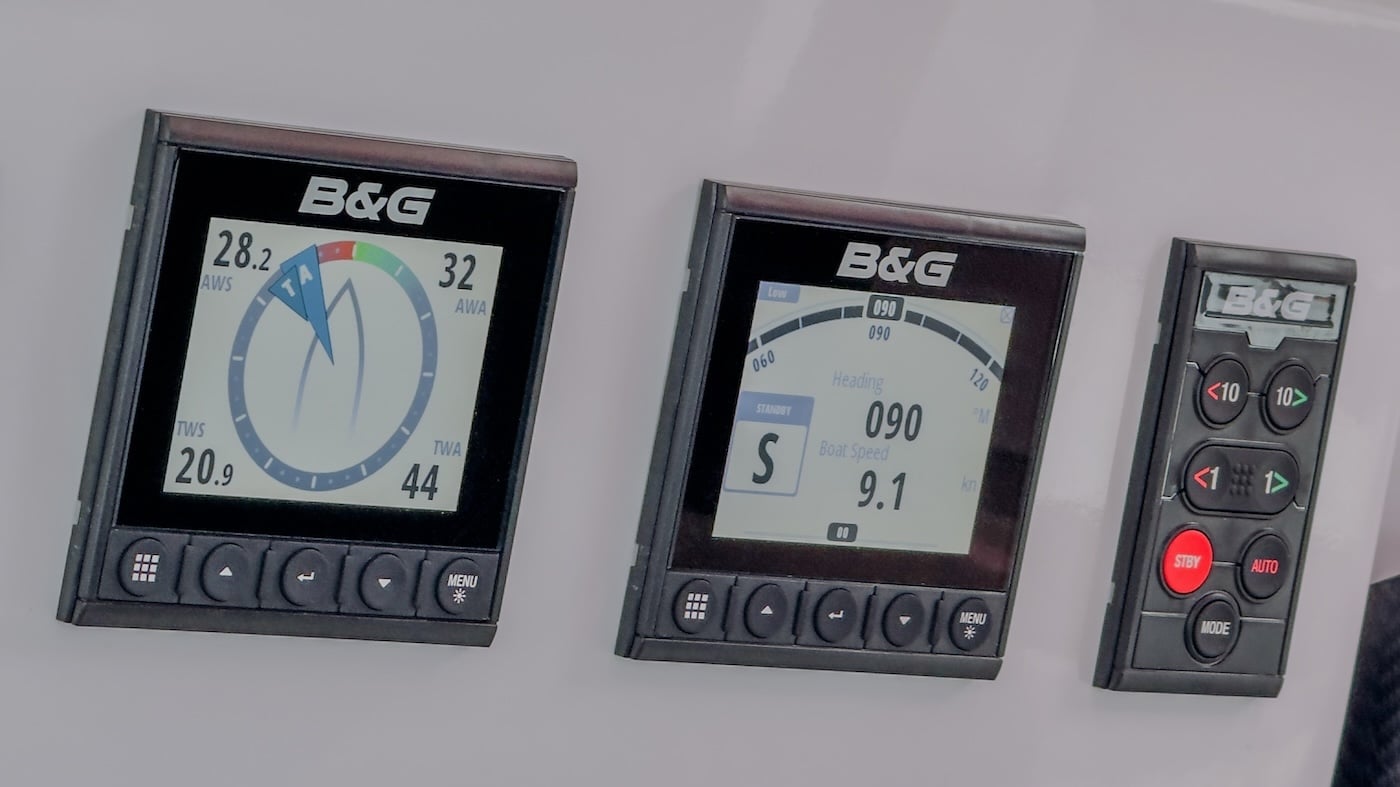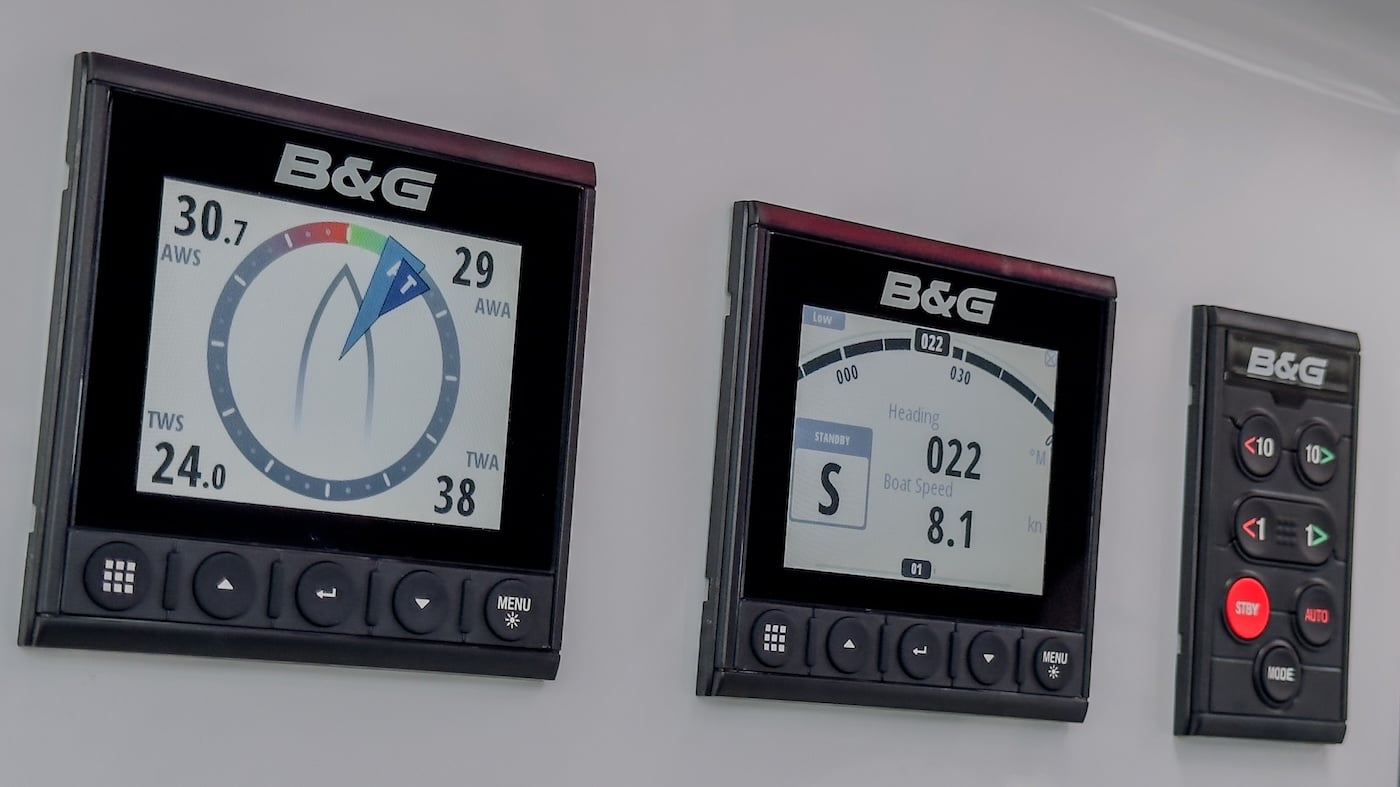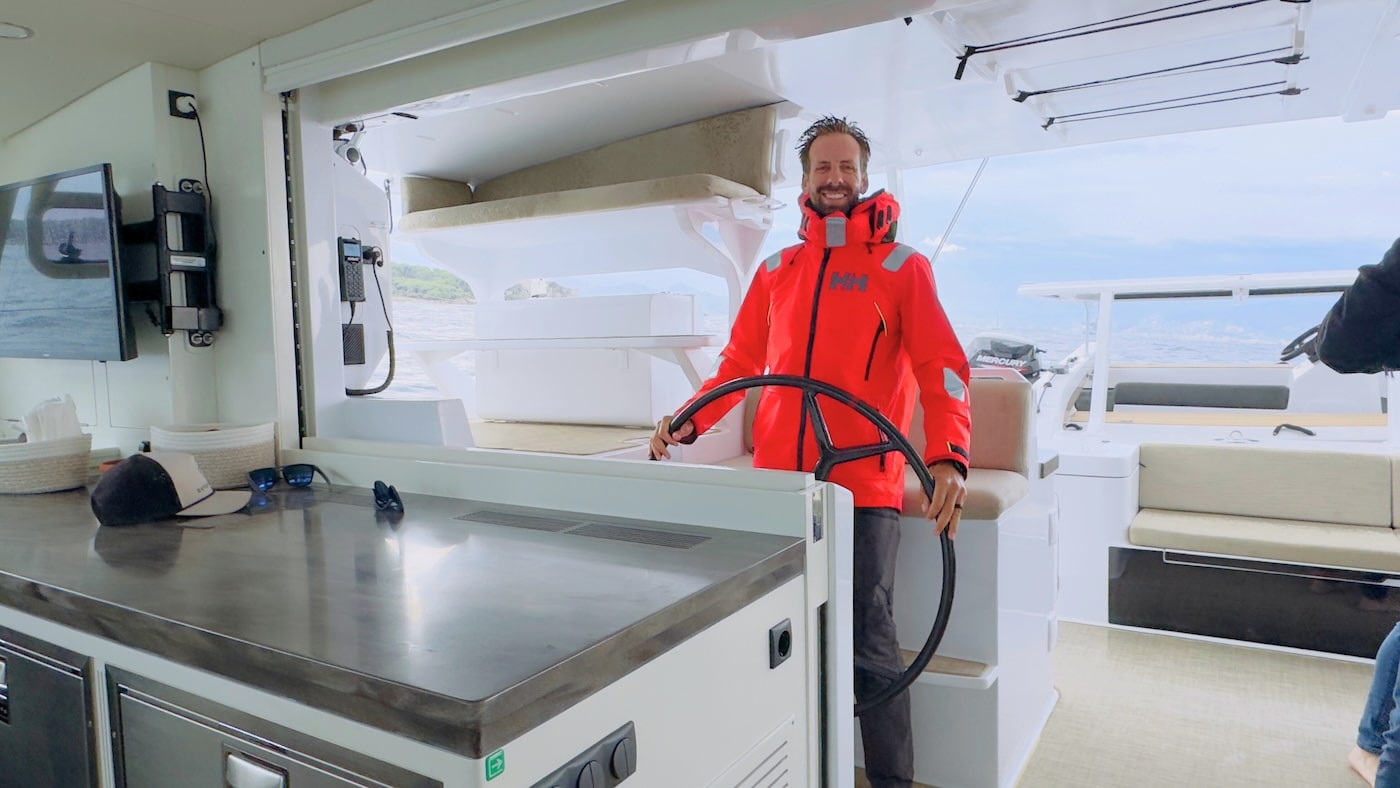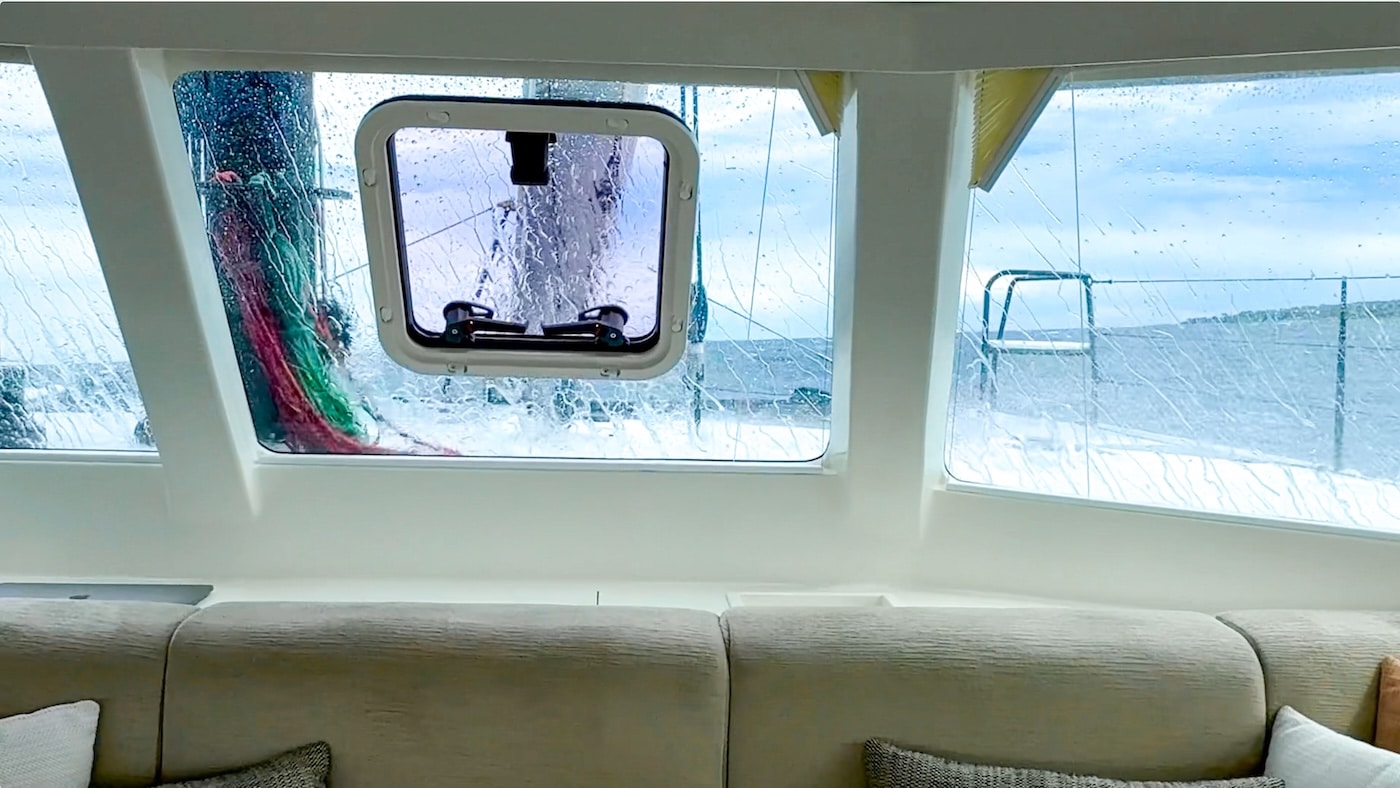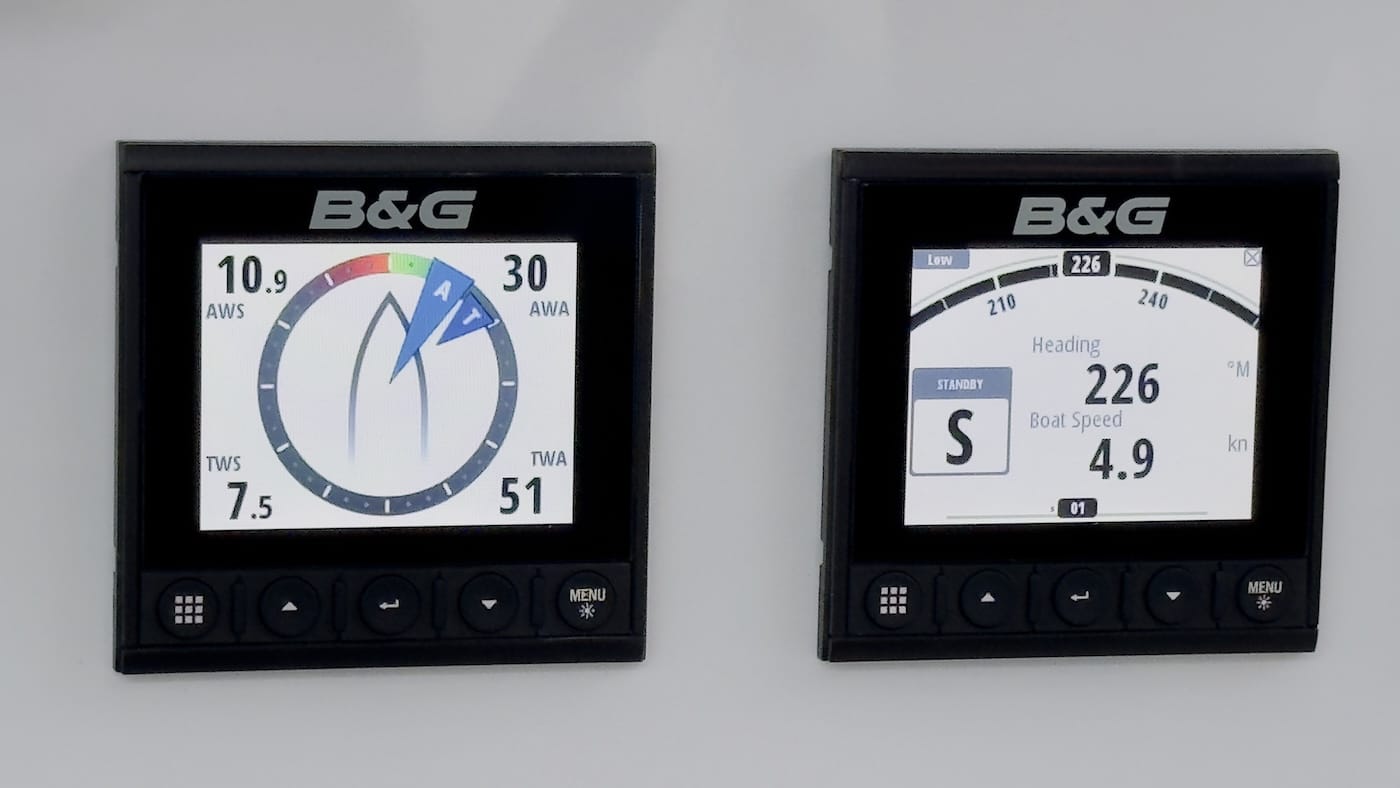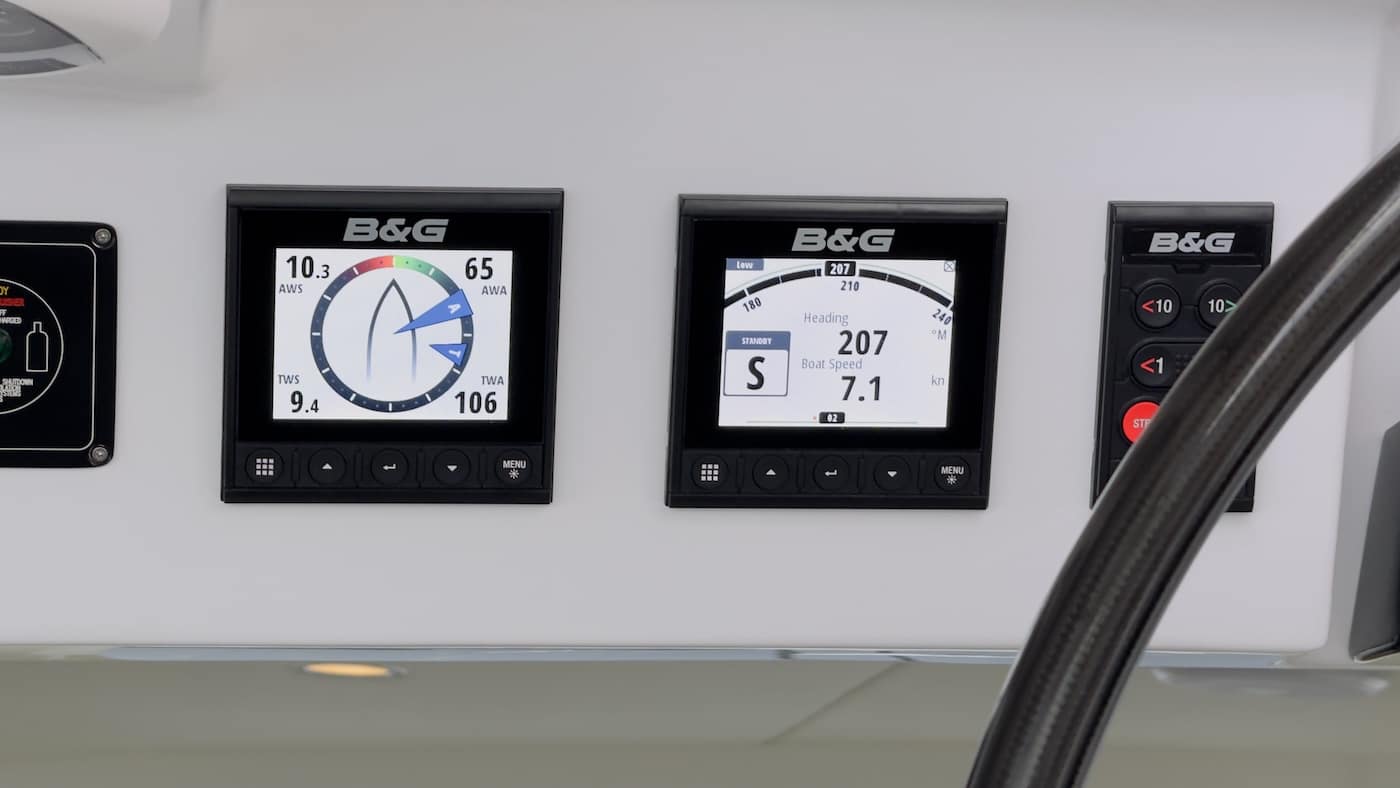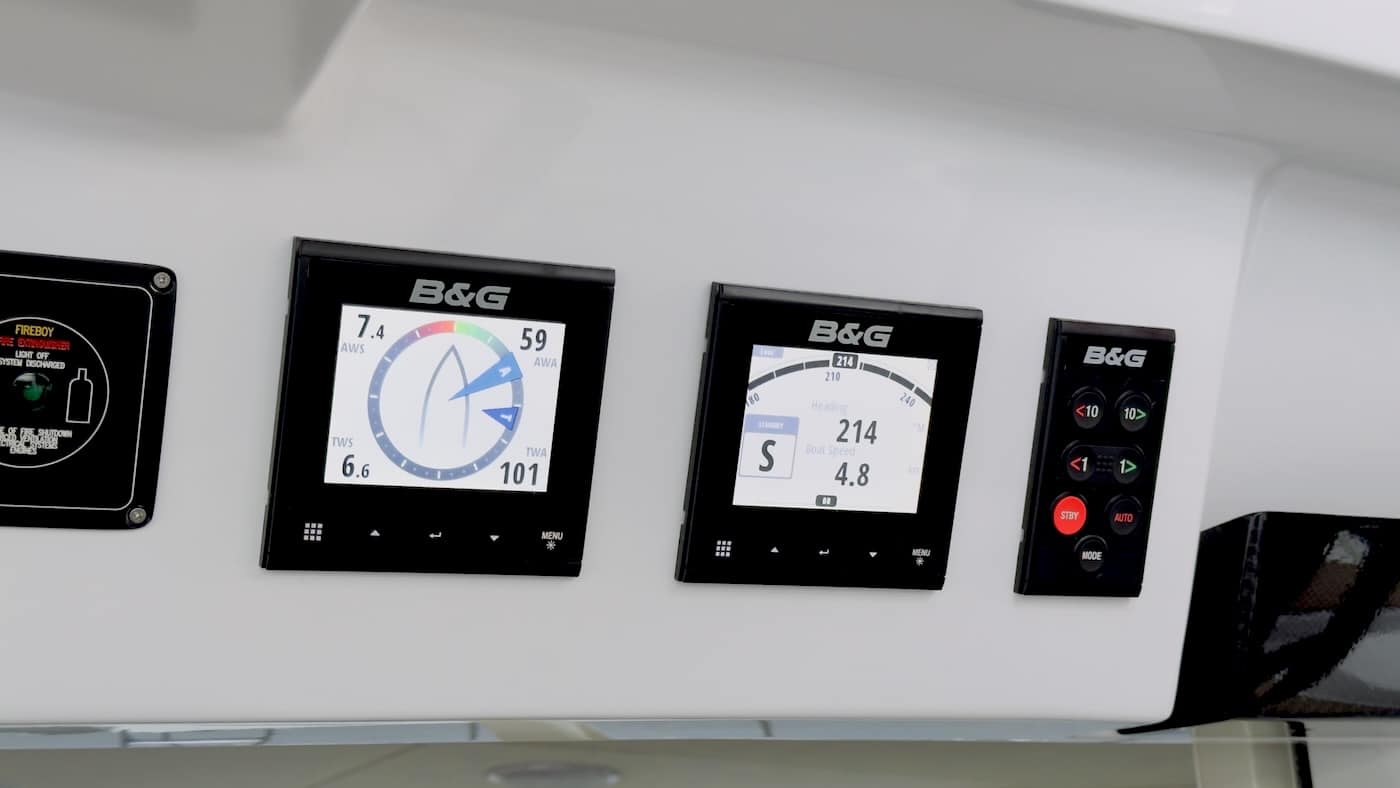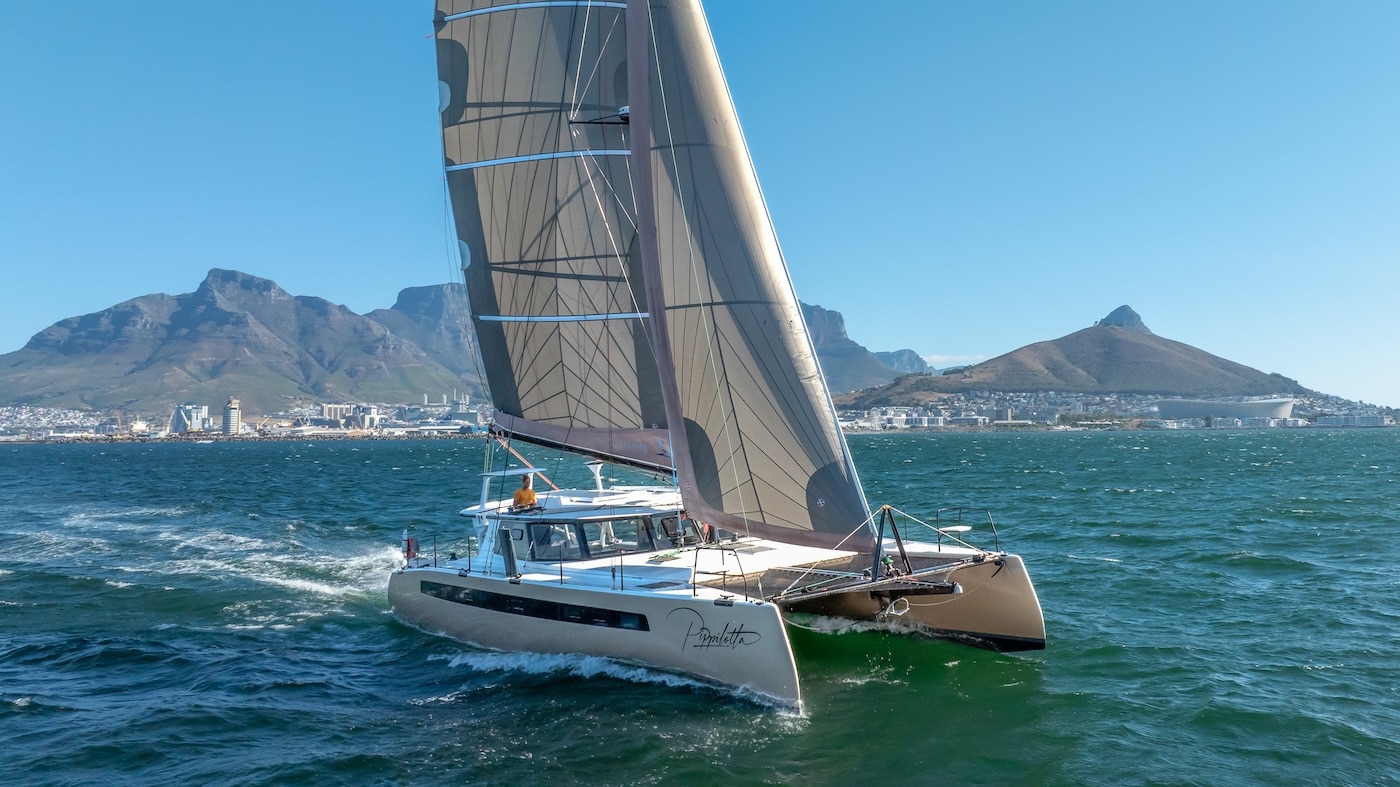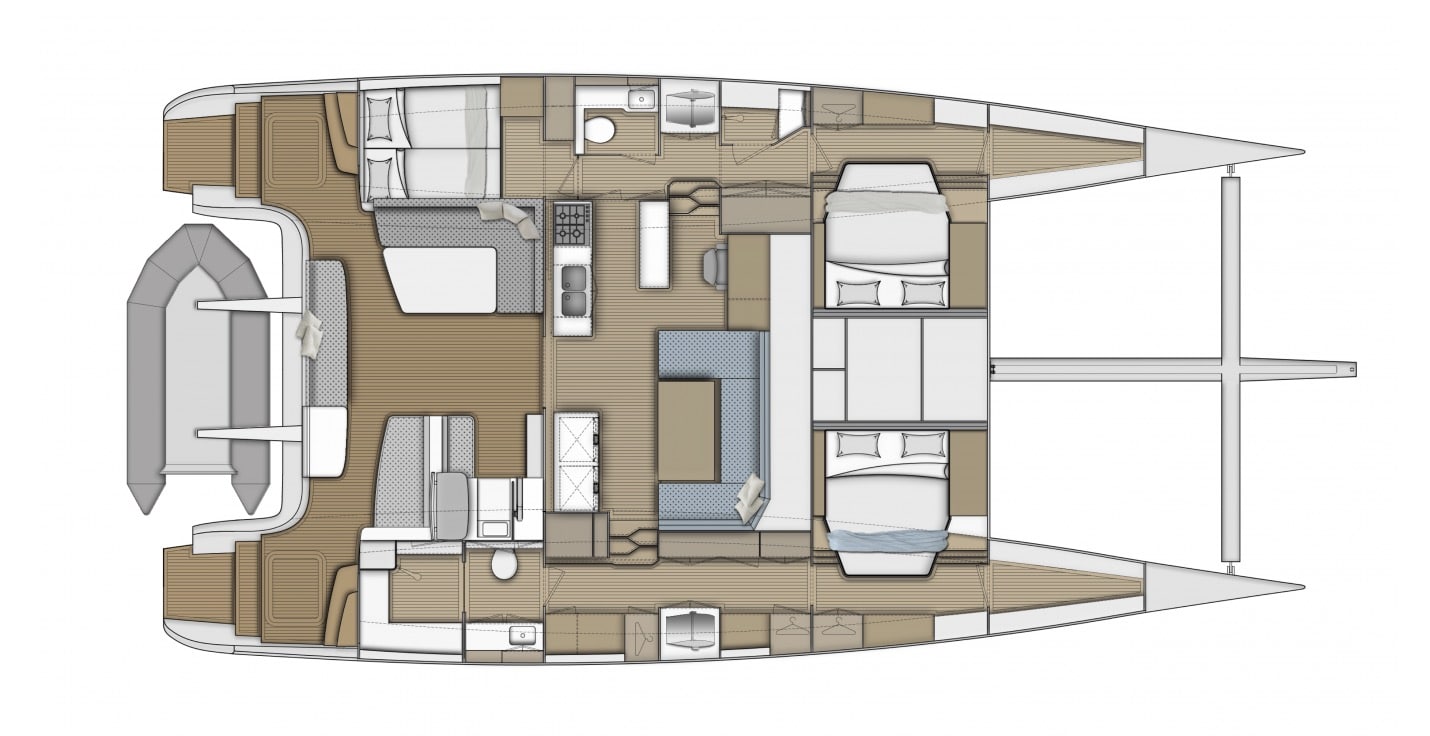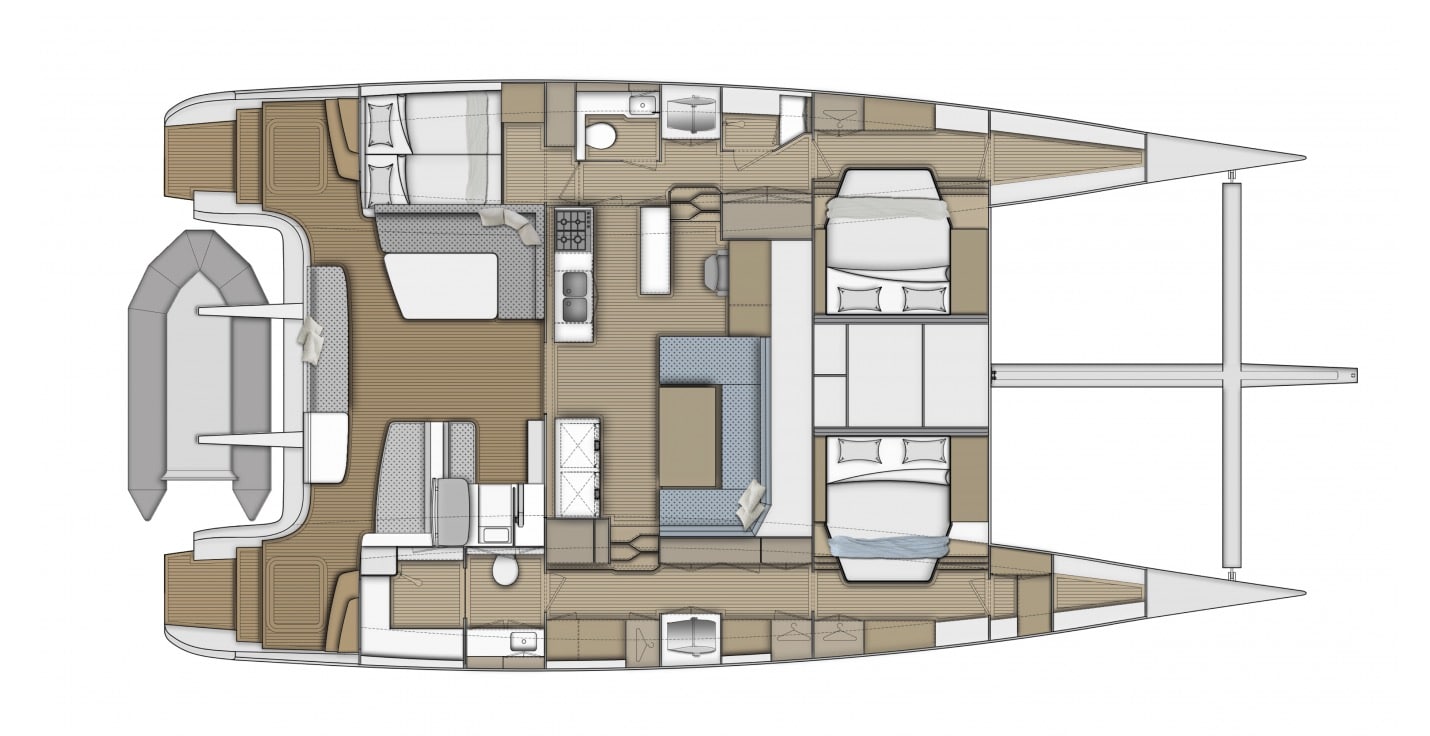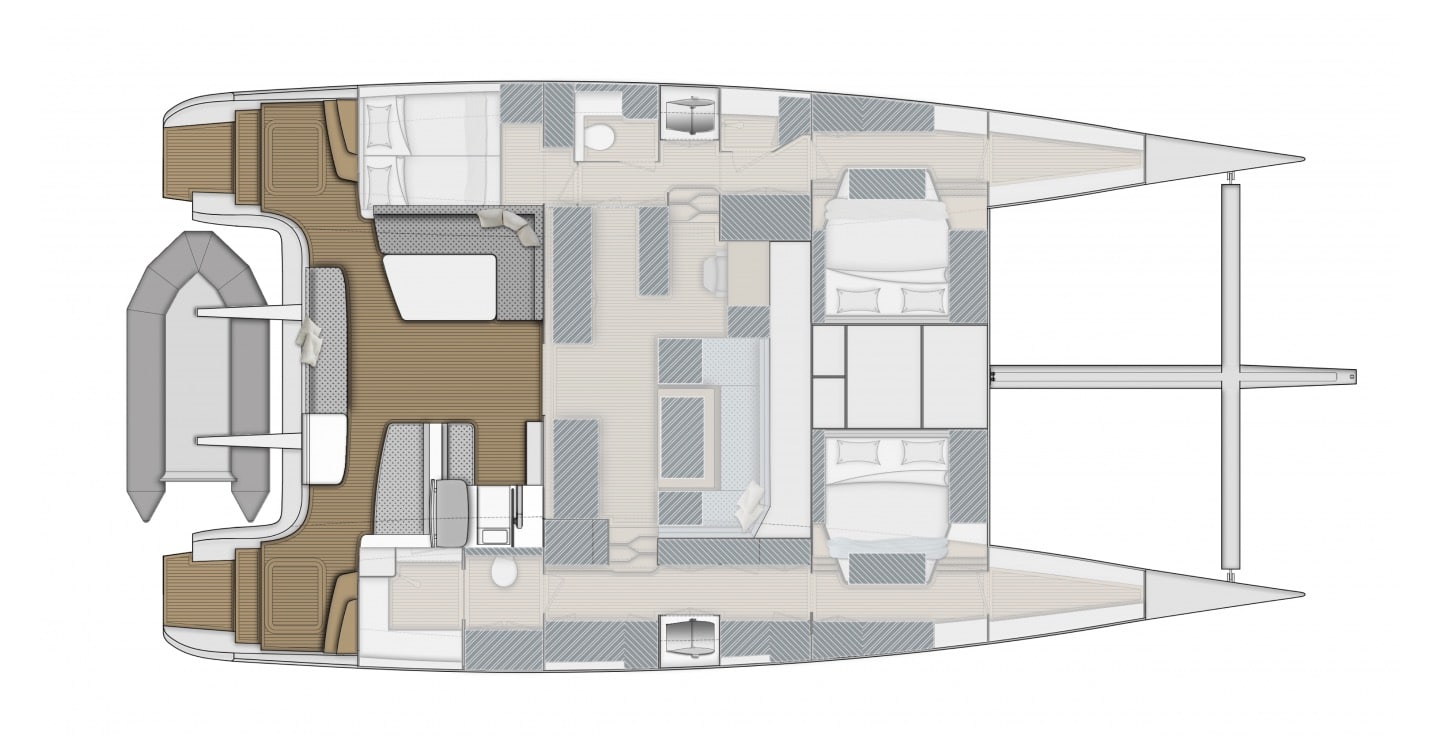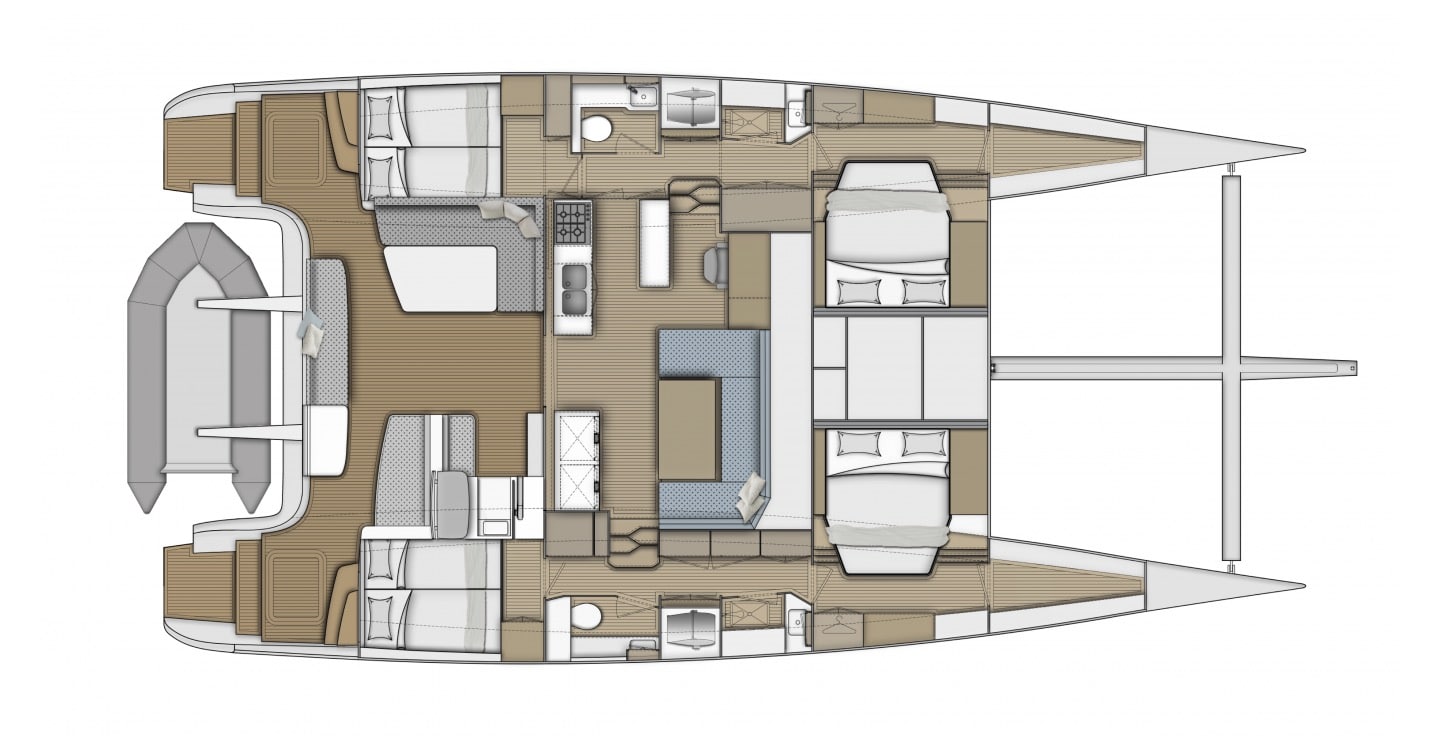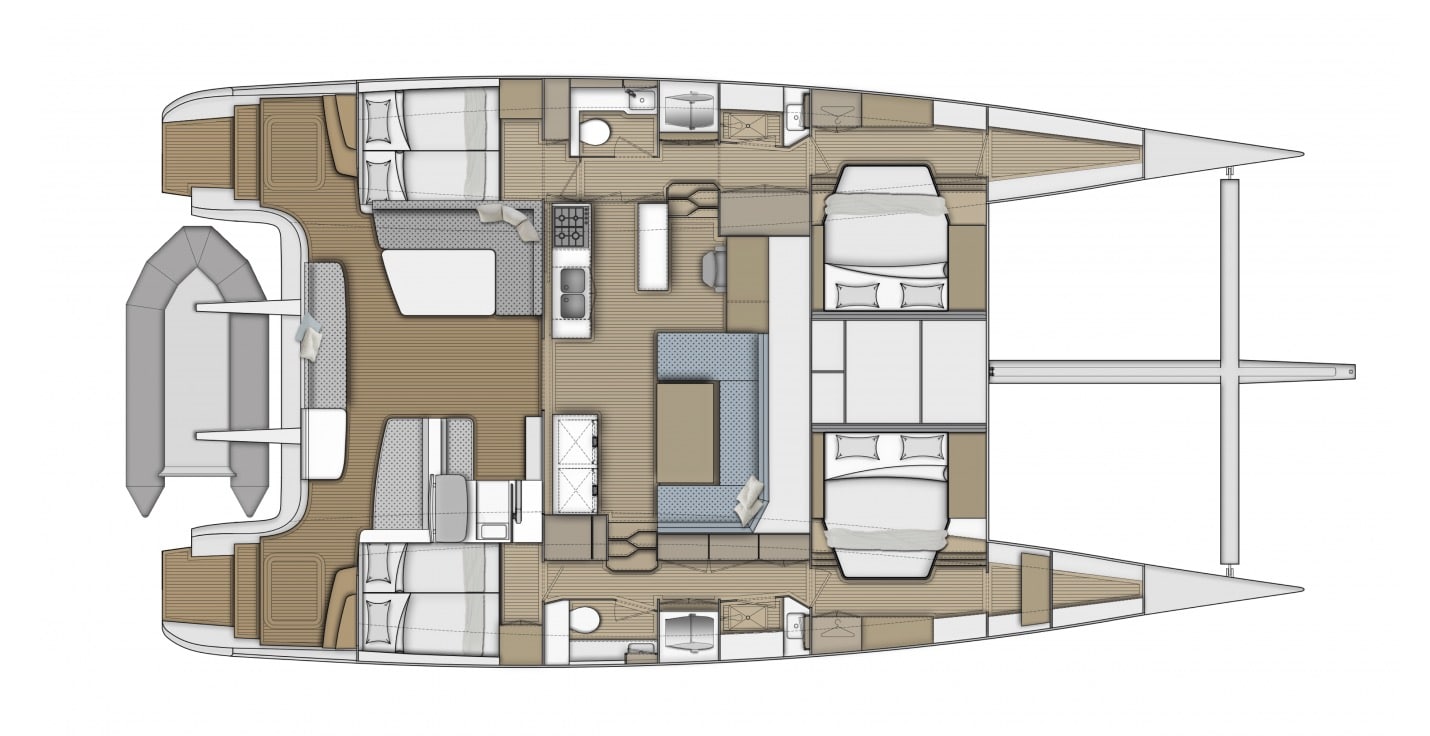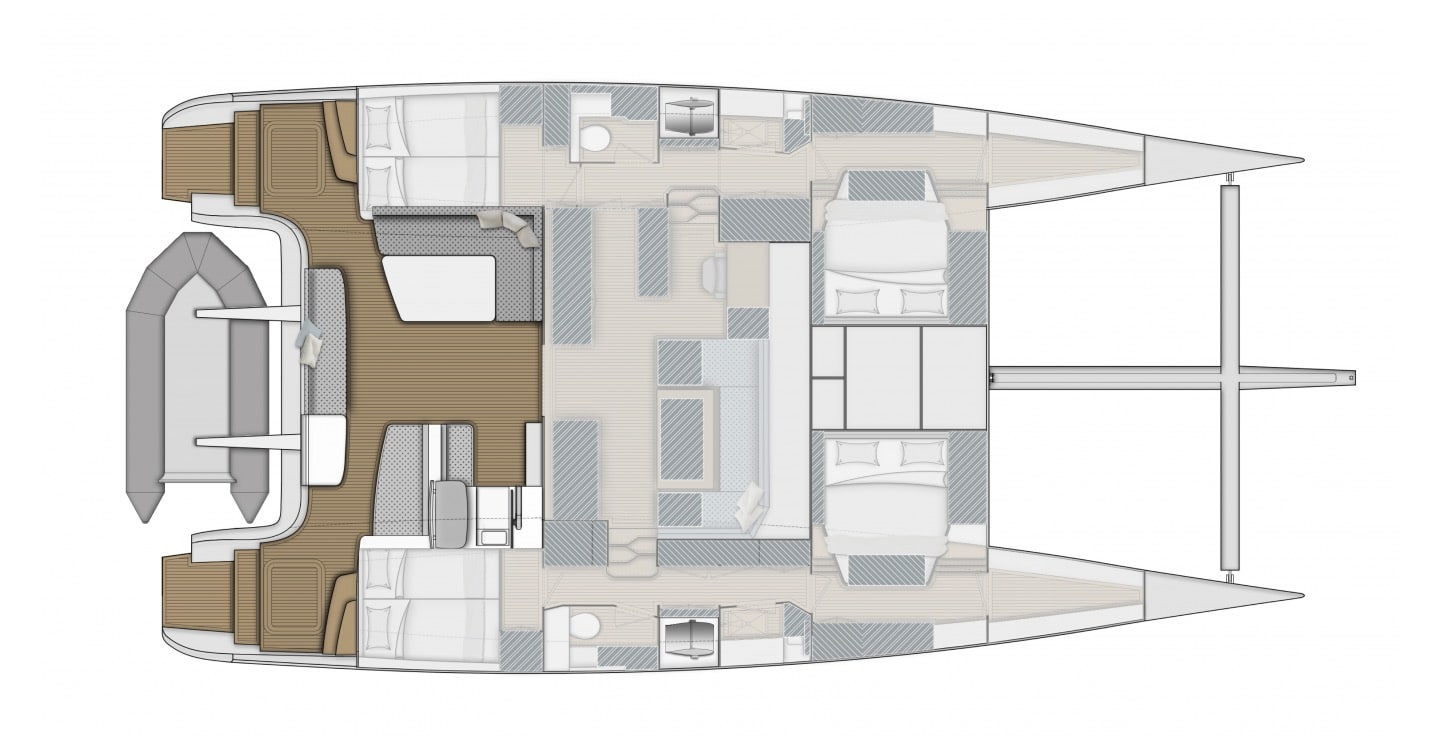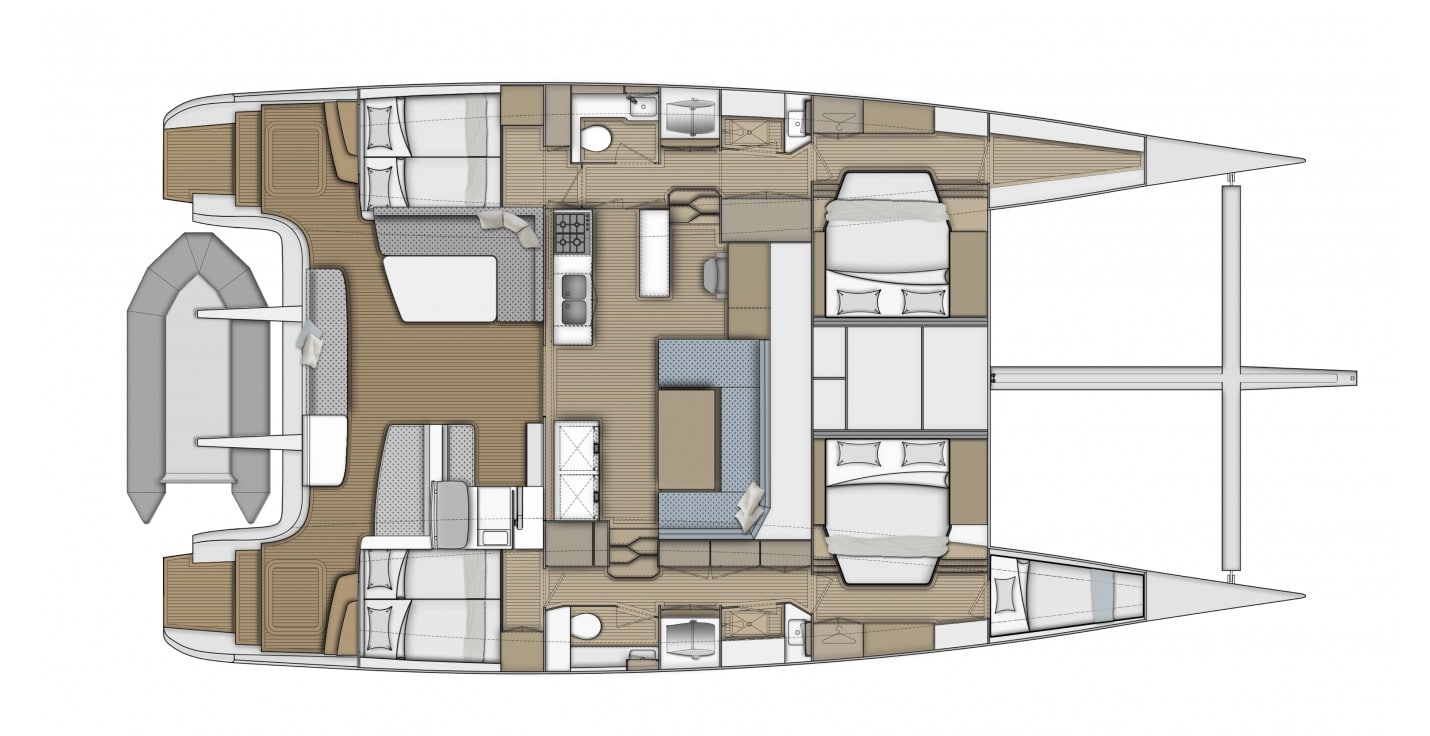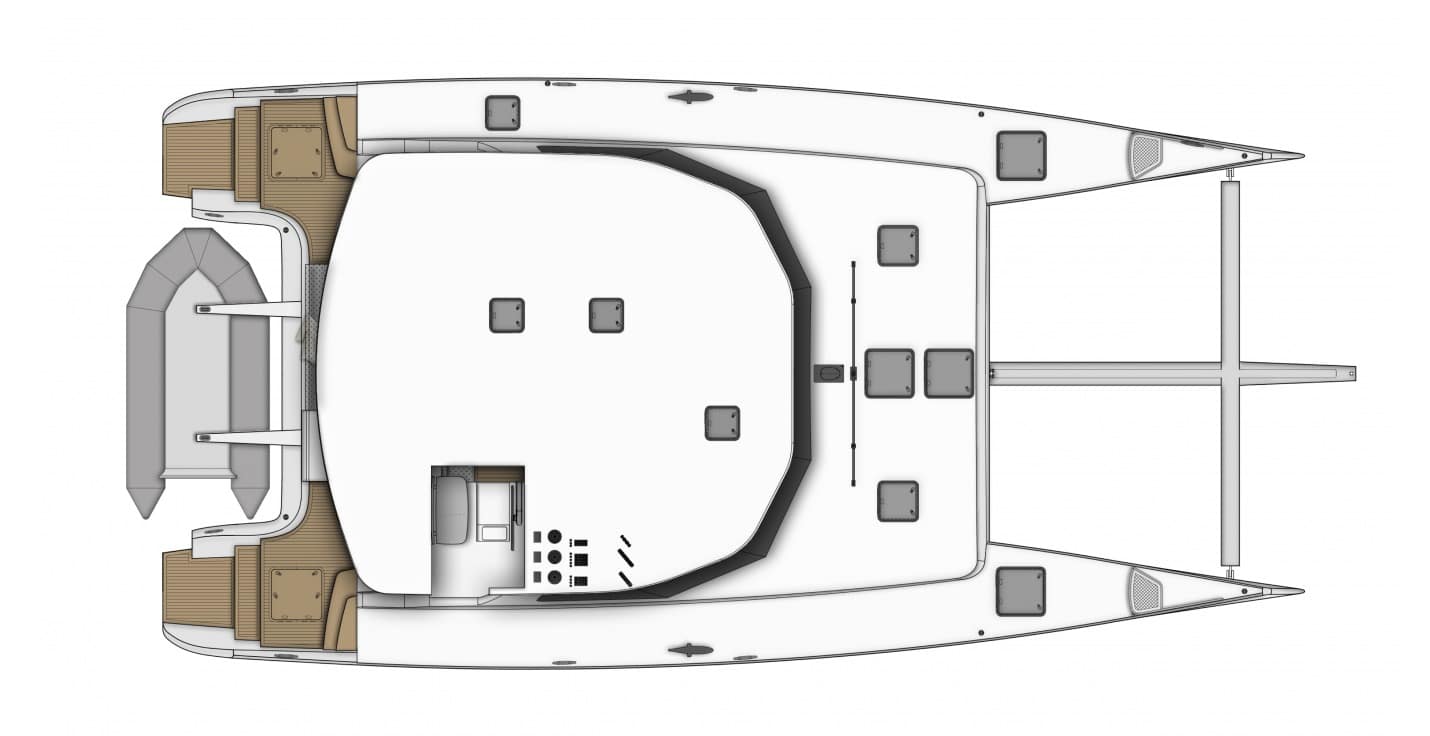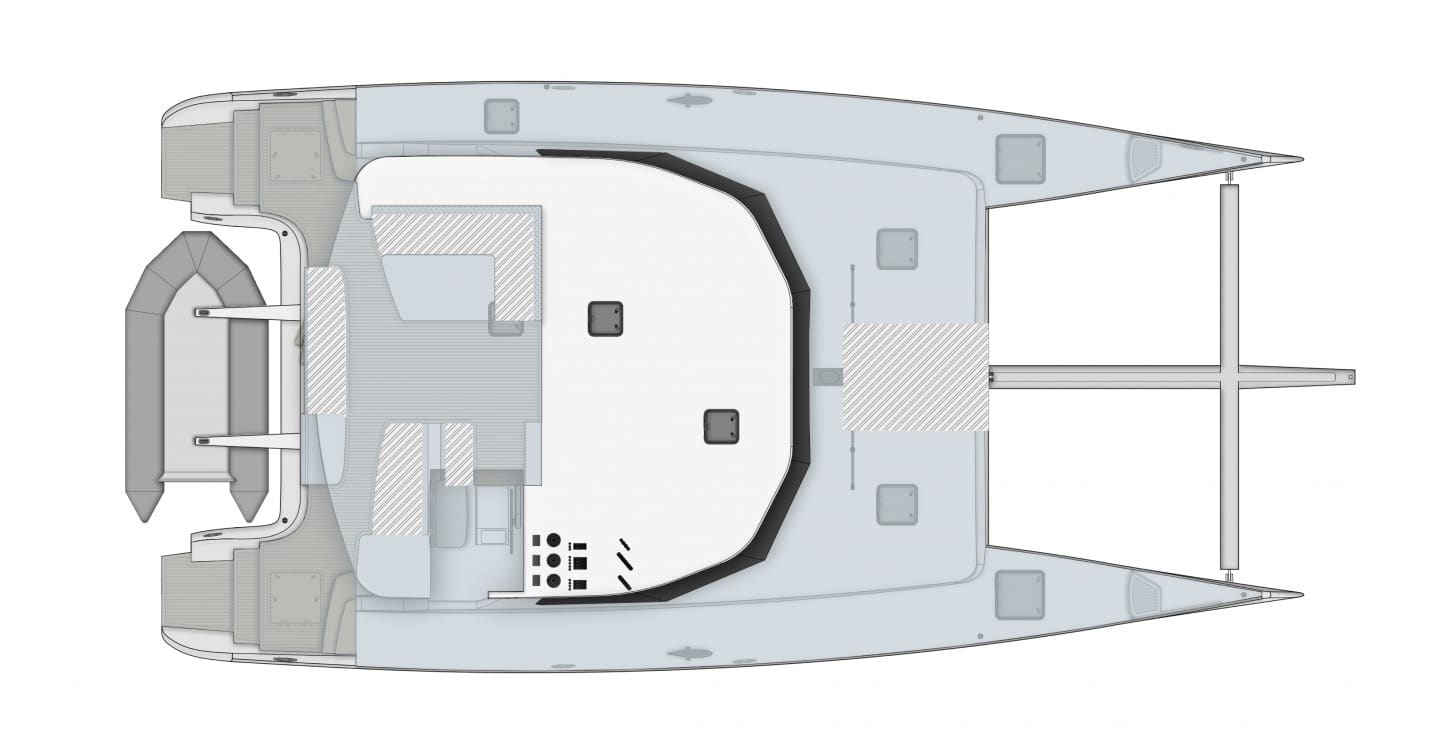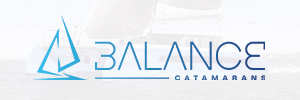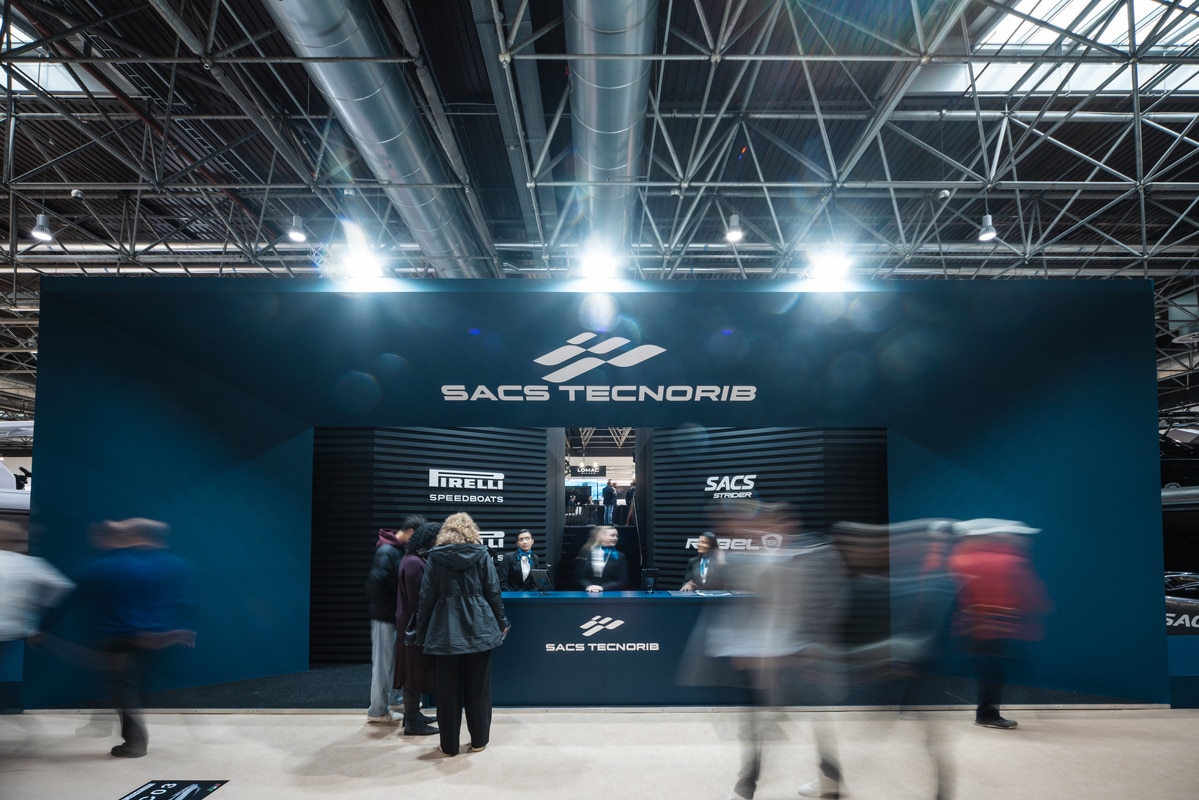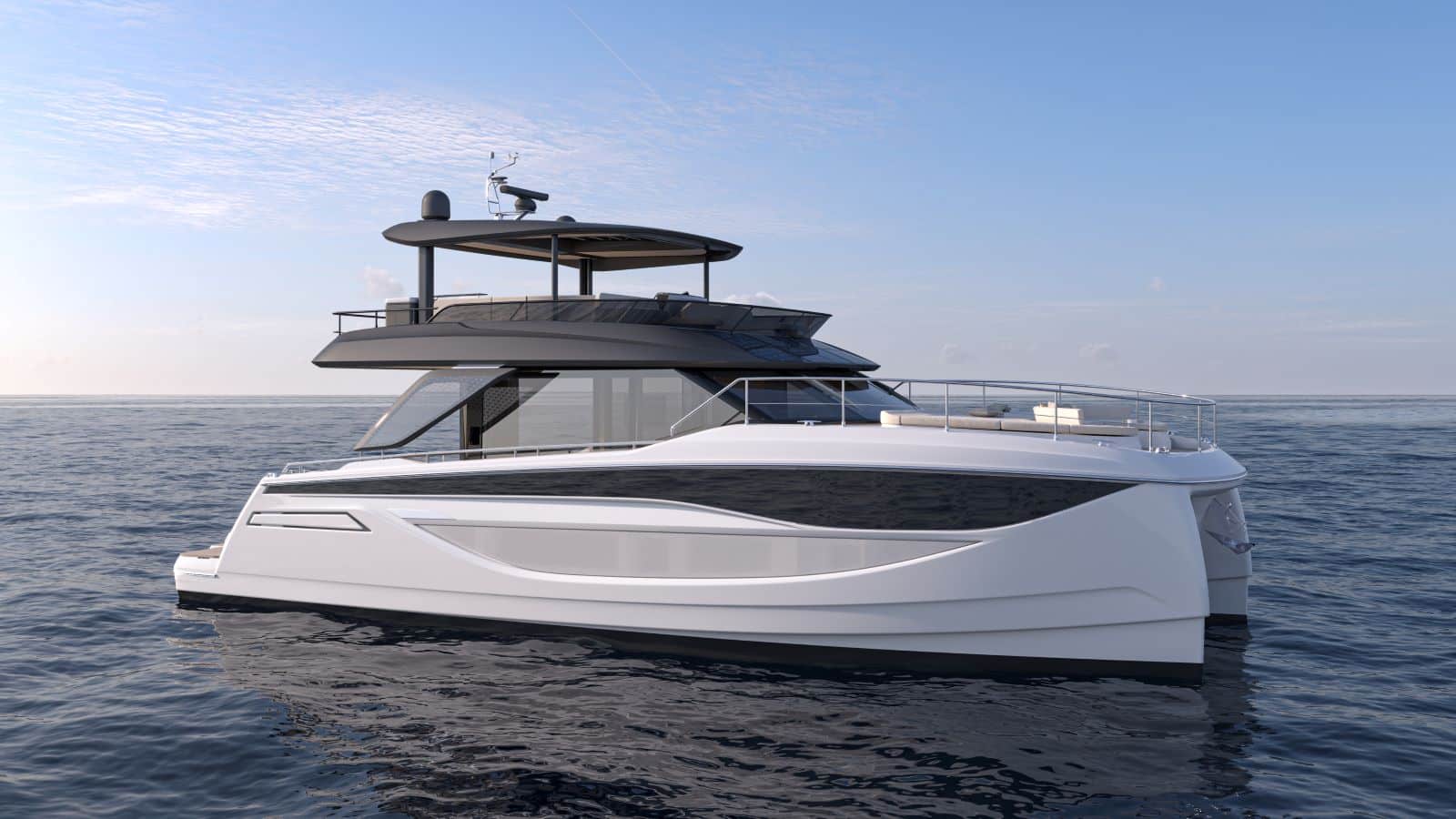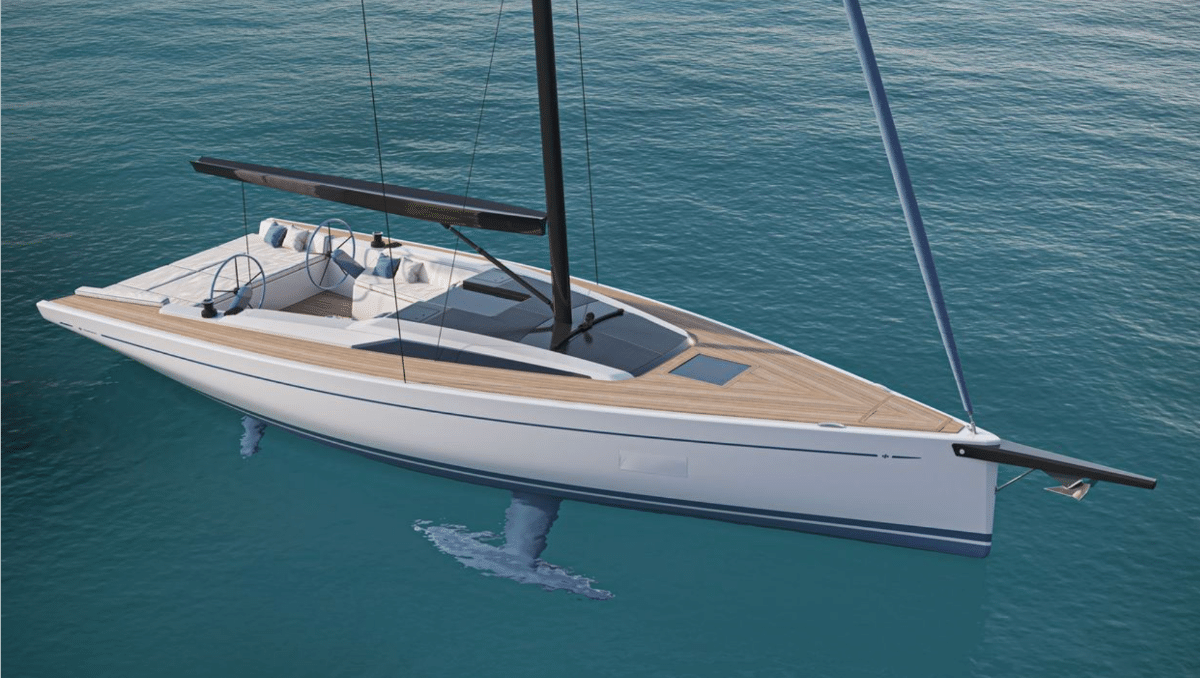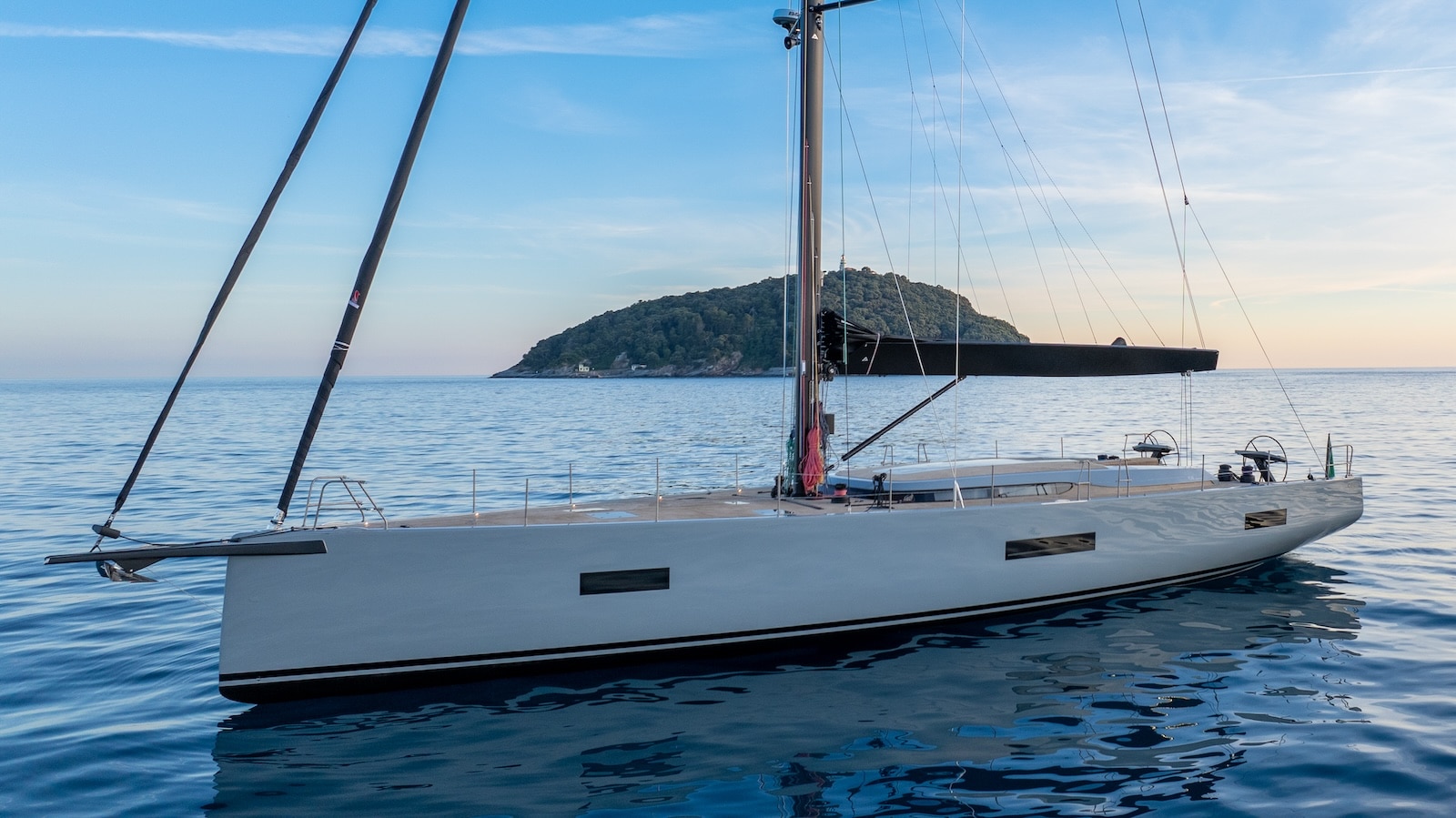Balance 526 is a truly captivating sailing catamaran. Built in South Africa with special attention to safety and performance, it quickly secured a strong place in the “blue water cat” segment, thanks to its distinctive qualities—as proven by the high number of units sold.
This alone could explain the reasons for this model’s success, yet in a market crowded with horrible catamarans that often resemble floating boxes more than sailboats, I believe the undeniable beauty of the Balance 526 has played a significant role. With lines that are both sporty and elegant, this catamaran wins you over at first glance.
A mix of qualities we couldn’t overlook, so despite the rather challenging weather, we jumped in the car and went to test it at sea.
Balance 526 Sea Trial
Today is a truly unusual day in Cannes. The sky is dark, with storms rolling over Port Canto one after another, unleashing downpours and gusts of wind that make the boats at their moorings sway.
Balance 526 awaits us at anchor just outside the port, although in these conditions it seems hard to believe we’ll even manage to climb on board. Luckily, a squall passes, and we quickly hop into the tender, making it aboard just before the next storm arrives.
Stepping onto the main deck of the Balance 526 feels reassuring; even in these weather conditions, everything here is dry and safe. The large hardtop perfectly shelters the entire exterior, and the access to the helm station is enclosed—if it weren’t for the gusts of wind, not a drop of water would get in.
We wait for yet another squall to pass, then lift the anchor and set off. The helm station of the Balance 526 is simply perfect; from here, you can hoist, ease, and trim the sails without ever having to take your hands off the wheel, which, in a market where many shipyards overuse the term “easy sailing”, has a truly special value since this catamaran really allows for genuine single-handed control.
From the wheel, everything is within reach—and here’s the genius touch—even at your feet. All the halyards and sheets arrive neatly at the stoppers, and from there, they connect to three electric winches controlled by six foot switches. The lines then drop neatly into three separate compartments below, guided downwards by gravity. It’s a brilliant system that genuinely enables single-handed handling, with the autopilot control always within reach.
We raise the mainsail with a reef already in place—there’s about 15 to 16 knots of true wind, and under normal conditions, we could easily keep the full main up, but with the sky still dark, there’s no reason to take unnecessary risks. We bear away and unfurl the self-tacking jib as the Balance 526 starts accelerating, the speed rising swiftly. In no time, we’re sailing at 10 to 11 knots, on a 60-degree apparent wind angle, and onboard comfort is absolute.
At the helm, this catamaran is lively and responsive, worlds apart from the muted sensation typical of pure cruising cats. Here, the pressure of the wind on the sails can be felt directly on the wheel, making it not only easy but also rewarding to steer while keeping a perfect angle to the wind.
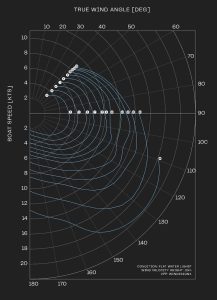
With the self-tacking jib, changing tack is a piece of cake; the Balance 526 slows down a bit, but with a firm hand, you’re on the new tack without a hitch.
I bear away to head back just as the sky darkens and the wind picks up to 24-25 knots. At a 100-degree apparent wind angle, the boat speeds along like a train, consistently sailing above 12 knots.
What I love about this sailing catamaran is the sense of safety it conveys—even in these conditions, there’s no lurching, no tendency to round up. It sails with impressive stability and steadiness, clearly designed to cover long, very long distances every day.
As the rain picks up, we close the sliding roof at the helm station, tilt the wheel downward, and continue sailing in complete comfort.
This maneuver is possible thanks to VersaHelm, a system developed by Balance Catamarans that allows you to “lower the wheel,” so you can steer sheltered from the elements or in colder weather. Visibility from the lower helm position is perfect at 360 degrees, making it not only comfortable but also very safe.
Then we get the wild idea to slip through the channel between the mainland and the Île Sainte-Marguerite, heading toward Golfe-Juan, where we should be sheltered. Conditions worsen in the channel: the wind picks up to 25-26 knots true (30-31 apparent), and with no island cover, we’re also taking on the waves, now over 2 meters high.
So we take a second reef in the mainsail and, in what’s typically the worst scenario for a sailing catamaran, we start tacking close-hauled against the sea and wind in a channel that, at its narrowest, is only about half a mile wide!
To my surprise, however, Balance 526 handles this extreme situation with remarkable ease, without a single hesitation. We’re consistently sailing between 8 and 9 knots at 30-35 degrees off the apparent wind, riding over these large waves and steering comfortably dry from the inside—it’s incredible. What impresses me most is that even close-hauled, this catamaran doesn’t slam into the waves!
As we approach Golfe-Juan, both the wind and sea gradually ease, and once we reach our destination, we drop anchor. We’ll use this pause to explore the Balance 526 and have a bite to eat. There are seven of us on board, but with the boat’s spacious layout, everyone fits comfortably. The monohulls around us are rolling noticeably, while we, warm and dry, enjoy an incredible level of comfort.
As we have lunch, the sky clears, the rain stops, and the wind dies down. So we open up the outside helm station again, adjust the wheel back into position, and we’re ready to set off once more.
Now we’re greeted by typical Mediterranean fair-weather conditions: light breeze and calm seas. We hoist the full mainsail, unfurl the self-tacking jib, and immediately—almost magically—the Balance 526 picks up speed. With 6-7 knots of true wind, we’re consistently sailing over 5 knots, hitting 6 when we ease out to 30 degrees apparent. The Balance 526 catches every light puff and converts it into speed, and steering with such a responsive wheel is pure enjoyment.
The wind builds slightly to around 9-10 knots true, and the catamaran speeds up to over 7 knots. The sky is clear again, and I find myself smiling, savoring these precious moments of sailing aboard a vessel that is, quite simply, extraordinary.
Conclusions
Balance 526 is a superlative catamaran. Built with skill by highly experienced South African artisans, it impresses not only with its performance but especially with its extreme ease of handling and the sense of safety and calm it conveys—even in tough conditions like today.
This sailing catamaran is designed for long-range cruising in maximum comfort and is incredibly effective in both light winds and stronger gusts, whether close-hauled or on a broad reach. Capable of remarkable daily mileage, it’s the ideal boat for anyone looking to embark on long cruises around the world or to explore the Mediterranean without ever needing to start the engine.
Balance Catamarans positions its pricing in the mid-to-high market range, but with, in my view, the best quality-to-price ratio in its class. However, looking at the resale values of this yard’s boats, it’s evident that depreciation is minimal, so buying a Balance is far from a risky investment—in fact, it’s quite the opposite.
Balance 526 has many strengths, and there are plenty of practical reasons that would justify such a well-considered purchase. Still, personally, I believe these catamarans are the most beautiful on the market, and falling in love with them is all too easy.
Balance 526 in detail
Built from epoxy resin with carbon reinforcements, Balance 526 is exceptionally well made. And that’s no surprise given the stellar team behind its design and construction. Phil Berman (founder, co-designer, and CEO of the shipyard), Anton du Toit (naval engineer and designer), and Jonathan Paarman (outstanding South African builder) are all renowned names in the world of sailing catamarans.
Onboard, everything you touch feels sturdy and substantial. Special attention has been paid to furniture and finishes, and the skilled hand of Balance’s artisans is evident everywhere—even in the most concealed storage compartments. Balance 526 also offers extensive customization options, allowing choices among numerous layouts, wood finishes, and fabrics.
Inside, despite a performance-oriented design, there’s abundant space everywhere. The main deck is inviting and designed for extended stays, with ample space both outside and inside, where the level of finish is even higher. Storage capacity is impressive, both in galley-dedicated cabinets and refrigerated spaces, making it exceptionally equipped for long cruises.
Balance 526 is available in the version we’re testing, a three-cabin layout (my favorite), as well as four- and five-cabin configurations—ideal for large families or those who plan to use the boat for high-end charters.
In our case, the layout across the two hulls is efficient and traditional: one hull is entirely dedicated to the owner, with a spacious master cabin and an impressively large head featuring a double shower. The forward section of the master cabin can be customized as an office, workshop, or walk-in closet, according to the owner’s needs and tastes.
The port hull, on the other hand, is designated for guests, with two cabins, each with its own en-suite bathroom. In this version, the forward cabin has a beam-facing bed similar to the master, while the aft cabin has a traditional layout.
For a full appreciation of the superb level of finishes and the generous space, this video is definitely the best way to experience it all.
Balance 526 – Technicals Specs
LOA | 16 m |
LWL | 15.64 m |
Max Beam | 8.26 m |
Draft (draggerboards up) | 1.12 m |
Draft (draggerboards down) | 2.16 m |
Draft (fixed draggerboards) | 1.37 m |
Mast height above the water | 23.93 m |
Dry Displacement | 12,500 kg |
Max Displacement | 15,625 kg |
Max Tender Length | 4 m |
Crane Max Load Capacity | 400 kg |
Max Tender Weight | 255 kg |
Engines | 2 x 57 hp Yanmar |
Fuel Capacity | 2 x 500 l |
Water Capacity | 2 x 390 l |
Black Water Capacity | 2 x 60 l |
Mainsail | 106 m |
Self-tacking jib | 43 m2 |
Reacher | 88 m2 |
Asymmetrical spinnaker | 240 m2 |


